——— T ———
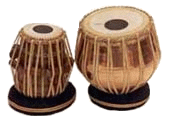
tab – short for tablature.
tabla – a pair of small drums attached together with one slightly larger than the other similar to bongos. They are used in Indian music and are played by striking with the hand and using pressure from the heel of the palm to vary the pitch.
tablature – a musical notation indicating the fingering on the frets of a stringed instrument. Called tab for short.
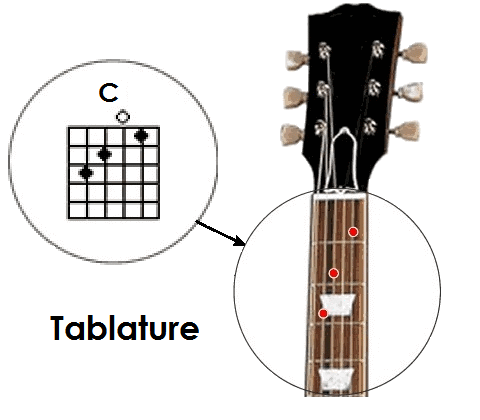
table of contents (TOC) – a track on a compact disc (CD) that contains information such as the number of tracks on the disc, their location, and their playing time. The TOC allows a CD player to quickly find and jump directly to a specific track.
tabletop – a format in which equipment or hardware is designed to sit on the flat surface of a desk or table, as opposed to being rackmounted. For example, many mixers and control surfaces come in tabletop format.
tach – short for tachometer.
tachometer – a device that generates pulses to indicate the speed as a recording tape moves through a tape deck. Called a tach for short.
tachometer signal – the pulses generated by a tachometer. Called a tach signal for short.
tach signal – short for tachometer signal.
tack piano – see honky-tonk piano.
tail – the end of a song or audio file, as opposed to the top or head (beginning) of a song.
tailored frequency response – a significant departure from a flat frequency response, usually designed to enhance the sound for a particular application. Also called a shaped response or tailored response.
tailored response – see tailored frequency response.
tail-out groove – see lead-out groove.
tails out – a method of winding recording tape onto a reel backwards so that the end of the tape (the tail) is on the outside and the the beginning is at the center of the reel. Tape stored in this configuration reduces the effects of print through. See also heads out.
take – (1) A single, continuous recording, either of several tracks at one time or of an overdub. Quite often during tracking, several takes of a performance are made, and the best one is kept. Sometimes the best parts of several takes are edited together to create the best composite take. (2) See playlist, definition #3.
take folder – see playlist, definition #3.
take notation – the writing down of details and comments regarding a take on a take sheet.
take number – (1) Before digital recording became common, it was not unusual to record many takes before obtaining an acceptable performance. These takes were usually numbered. (2) During much of the era of the 78-rpm record, before recording tape came into common use, recordings were cut directly to disc. Therefore, a new pressing would require a new take, and take numbers would be included in the matrix area.
take sheet – a form on which an engineer writes information and comments about each take.
take-up disc – see take-up platter.
take-up motor – the motor on a tape machine that applies tension to the recording tape during play and moves the tape during fast forward.
take-up platter – the round disc on a tape machine that is driven by the take-up motor and holds the take-up reel, sometimes with a locking mechanism. Also called a take-up turntable or take-up disc. See tape machine for diagram.
take-up reel – the spool onto which a recording tape is wound during play. See tape machine for diagram.
take-up tension – the force applied by the take-up motor of a tape machine during play to keep the tape evenly wound on the take-up reel.
take-up turntable – see take-up platter.
talent cueing – see interrupted foldback. Sometimes spelled talent cuing.
talkback – a system on a mixer or console that allows the engineer to communicate with the personnel in the studio or live room over headphones or speakers.
talkback microphone – a microphone used in a talkback system that allows the engineer and/or producer in a studio control room to communicate with the musicians in the studio. A talkback microphone may be freestanding or may be mounted in the mixing console, monitor controller, or other device.
talkbox – a guitar effects device that allows the human voice to modulate the guitar signal.
talkover – (1) A switch on radio station control boards and DJ mixers that automatically ducks the music allowing the DJ to speak over it. (2) The act of speaking while music or other program material is playing in the background.

tangency – the alignment of the head gap with the wrap of the recording tape on a tape machine. The tape should contact the head the same amount on either side of the gap. Poor tangency leads to uneven head wear.
tangential mode – one of the three room modes in which resonance in a room is caused by sound reflecting off any two pair of opposite surfaces. The other two modes are axial mode and oblique mode.
tank circuit – see LC circuit.
TAO – Track-At-Once. See optical disc recording modes.
tape – (1) Short for magnetic recording tape. (2) To record music or other programs even if the storage medium is not magnetic tape. (3) A strip made of rubber, cloth, vinyl, and other materials with adhesive applied to the back, usually coiled into rolls, such as adhesive tape or gaffer's tape.
tape backing – see tape base.
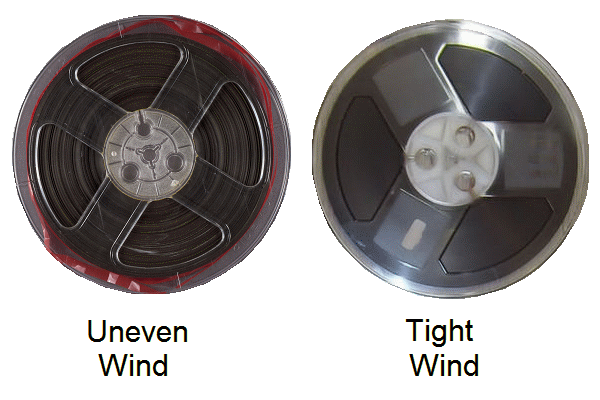
tape base – the thin ribbon of material that supports the magnetic layer of magnetic recording tapes. Early formulations of recording tape used cellulose acetate, but this material became brittle with age. For a short time, polyvinyl chloride (PVC) was used. Since the 1960s, the prevalent material has been polyester, which also goes by the Dupont trademark, Mylar®. The problem with tape made with a polyester base is that a tape pack wound too tightly can stress the tape, while too loosely can result in nonlinear deformation, causing playback distortion. When the temperature or humidity changes, the tape pack will undergo expansion or contraction that can distort the tape backing. To reduce these problems, magnetic tape should be stored in an environment with a stable temperature and humidity. Also called substrate, backing film, support film, tape backing, or carrier.
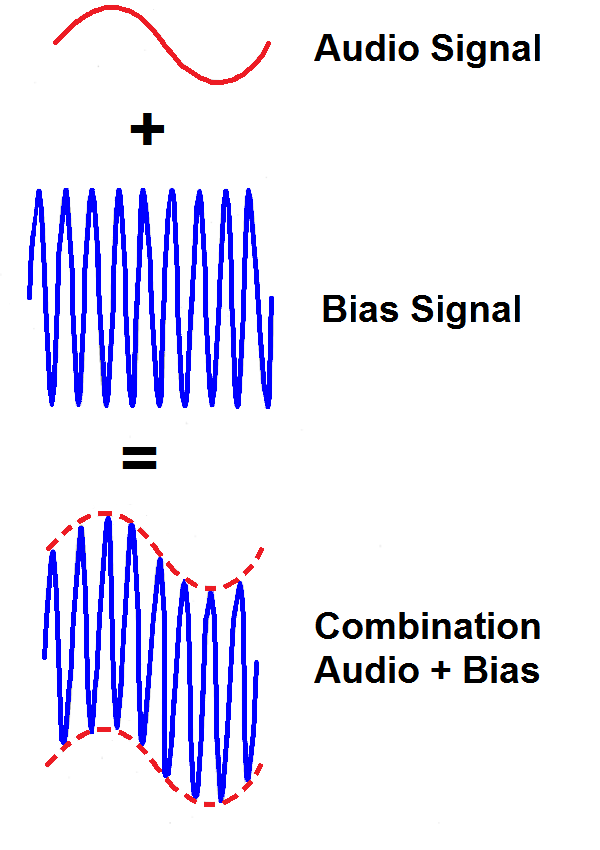
tape bias – two processes used to improve the fidelity of analog audio recordings on magnetic tape: dc bias and ac bias. Magnetic tape has a nonlinear response, especially at low signal levels, and bias pushes the signal into a more linear zone of the tape resulting in lower distortion. DC bias, which was used on some early tape recorders and later on some inexpensive cassette recorders, was the addition of a direct current to an audio signal. The main disadvantage of dc bias was that it increased the noise level on playback. AC bias is the primary method of reducing distortion on later model tape machines. It consists of an ultrasonic signal (typically between 40 to 150 kHz) that is added to an audio signal. The bias is designated as “normal” or “high,” depending upon the type of tape being used. Some tape machines provide for adjustable bias. As bias is reduced, there is more high frequency headroom, but dynamic range is reduced, distortion increases, and the saturation level is reduced. See also hysteresis.
tape bias noise – see bias noise.
tape binder – see binder.
tape cartridge – a loop of recording tape contained in a plastic housing once used in broadcast studios for playing short messages and commercials (see Fidelipac) or in consumer playback units to play music (see 4-track and 8-track cartridges). Called a cart for short.
tape coating – see magnetic coating.
tape deck – see tape machine.
tape delay – a delay created using a tape recorder to produce what is called a slapback echo or slapback delay. Originally, some of the signal from the playback head would be mixed back into the signal going to the record head. Because the record and playback heads on a typical Ampex recorder were 2.58 inches (6.55 cm) apart, a delay of 172 ms was produced when using a tape speed of 15 ips. Later, special units were devised that used a tape loop to feed the signal back into the recording. These devices allowed the operator to vary the tape speed and thereby adjust the time between echoes. Legend has it that Sam Phillips, owner of the legendary Sun Studio, discovered tape echo by mistake. While using a reel-to-reel recorder he accidentally fed the playback signal back into the recorded signal. Whether or not that is true, he made the effect famous. Sometimes called a tape echo.
tape disc – see tape platter.
tape distortion – a distortion of the audio signal when a recording is made on magnetic tape as it approaches saturation. The effect is determined by many factors including tape formulation, tape head construction, tape speed, tape width, tape equalization, and the amount and type of bias. These factors introduce distortions of harmonic content (especially at low frequencies), irregularities of the phase and frequency response, and reductions in dynamic range (primarily higher frequency transients). If not overdone, some of these effects are what is termed “tape warmth.”
tape echo – see tape delay.
tape equalization – an equalization curve that is applied to magnetic recording tape by a tape recorder during recording. The equalization depends of the tape type. Type I tape uses a equalization of 120 μs, while Type II through IV, use 70 μs. Tape EQ is specified by time constants (τ) that define the corner frequency (Fc). The corner frequency can be calculated using the formula, Fc = 1/(2 π τ). See also NAB curve, CCIR curve, and IEC curve
tape era – see magnetic tape era.
tape guide – a roller or post used to position the recording tape correctly as it passes along its path on a tape machine.
tape head – an electromagnet in a tape recorder that records, plays back, or erases audio signals onto or from magnetic tape. A professional recorder typically has three heads (record head, playback head, and erase head) while consumer recorders can combine theses functions into one or two heads. See tape machine for diagram. See also head stack.
tape head cleaner – a solvent for cleaning the record and playback heads, rollers, and tape guides on tape machines and video recorders. Solvents include alcohol (usually isopropyl alcohol) and amyl nitrite (available commercially as a video head cleaner). Acetone is not recommended as it can damage plastic parts, and Freon was discontinued in 1995 due to damage to the ozone layer.
tape hiss – the background noise on a tape recording caused by the random position of the magnetic particles on the recording tape. See also Dolby and the Barkhausen effect.
tape hub – the center of a tape reel, which on some types of reels is separate and used to mount the reel on the tape machines. See also NAB hub.
tapeless studio – a recording studio that uses exclusively digital recording and playback equipment.
tape lifter – a device on a tape machine that pulls the recording tape away from the heads during fast forward and rewind to minimize head wear and to stop sound output.
tape loop – a piece of magnetic recording tape with the ends spliced together to repeatedly play a sound.

tape machine – a device for recording and playing back audio on magnetic recording tape. It records an audio signal by polarizing magnetic particles on a tape in proportion to the audio signal as it moves across a tape head. When played back the polarizations in tape induce electric signal in the tape head which can be reproduced as audio. Also called a tape recorder or tape deck. See also open reel and cassette.
Profession Tape Machines Typical Configurations |
|
| Tape Width (in) | Track Count | 1/4 | 2 |
|---|---|
| 1/2 | 3 or 4 |
| 1 | 8 |
| 2 | 16 or 24 |
| 3* | 32 | *Not Common |
tape noise – the noise that is specifically due to the recording tape itself. There are several types of tape noise: (a) bulk-erased noise, the noise caused by bulk-erasing a tape, (b) zero-modulation noise, the noise present when no signal is recorded (typically 3 to 4 dB higher than the bulk-erased noise), (c) bias-induced noise, the difference between bulk-erased and zero-modulation noise, (d) saturation noise, the noise that occurs when reproducing a uniformly saturated tape caused by imperfect particle dispersion (typically 15 dB higher than the bulk-erased noise), (e) dc noise, the noise that occurs when playing a tape that has been non-uniformly magnetized (due to surface irregularities and asperities) with direct current going to the record head (which can be as much as 20 dB higher than bulk-erased noise), and (f) modulation noise, the noise due to variations in the signal output caused by poor particle dispersion and surface asperities. See also system noise and equipment noise.
tape operator – an assistant who loads, unloads, and operates a tape machine.
tape oxide – see magnetic coating.
tape pack – the way that a recording tape is wound onto a tape reel. A good pack has the tape wound consistently and evenly with no edges exposed that can be damaged.
tape path – (1) The direction in which magnetic recording tape passes across the heads in a tape machine. (2) The pathway that magnetic tape takes on a tape machine as it proceeds from the supply reel passing over and around various guides and rollers, across the heads, and back to the take-up reel.
tape platter – one of two round discs found on a tape machine that holds the tape reels in place, with one being the supply platter and the other the take-up platter. Also called a tape disc or tape turntable. See tape machine for diagram.
tape player – a piece of audio equipment used to playback magnetic recording tape and which may or may not have recording capabilities. See also tape machine.
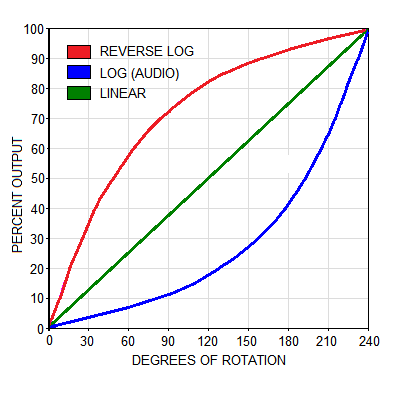
taper – (1) Fans who record concerts from the audience. Although the practice was originally illegal and was used to produce “bootleg” recordings, the practice became acceptable when some bands, notably the Grateful Dead, began encouring the practice. (2) The way in which the resistance varies as the armature (wiper) of a potentiometer (pot) is rotated (or moved if a slider). There are many tapers, but only two main ones: A linear taper (called a B-taper in the US and Asia or A-taper in Europe) is one in which the resistance varies linearly as the wiper moves. A logarithmic (log) taper is one in which the resistance varies logarithmically as the wiper is moved. It is also called an audio taper as it is most commonly used for audio volume controls, because the ear responds logarithmically to increases in sound levels. It is designated as an A-taper in the US and Asia, but a B-taper in Europe, and sometimes called a D-taper.
The reverse logarithmic taper is sometimes called an anti-log taper, a reverse audio taper, or an RD-taper (for reversed D-taper), but is usually designated as a C-taper. The MN taper (called a balance pot) is a special taper developed for home stereo balance controls, consisting of two sections (one for each channel) operating in opposite directions, with the first half of travel of each section having zero resistance and the second half being a linear taper. There are several other less common versions such as E-, G-, K-, S-, and W-tapers. Because of the confusion with the letter designations, it is best to refer to these by their name or function. Taper is also called potentiometer law.
tape recorder – see tape machine.
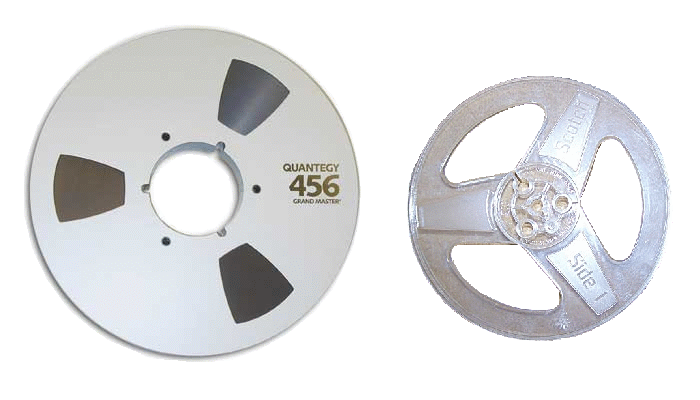
tape recording – (1) The process of storing audio signals on a magnetic recording tape for subsequent reproduction or broadcast. (2) A broadcast or performance recorded on magnetic tape. (3) A tape on which sounds have been recorded.
tape reel – the spool onto which magnetic recording tape is wound. Reels come in diameters of 3 inches, 5 inches, 7 inches, and 10½ inches for use with various widths of tape. Reels of 7-inches and smaller fit onto splined ¼-inch shaft known as a cine spindle. NAB reels (10½-inch metal reels) used an NAB hub. See tape machine for diagram.
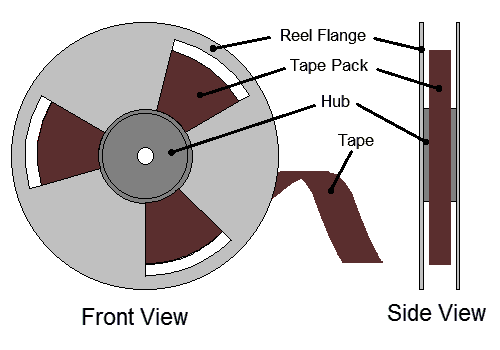
tape return – an input to a mixer from a multitrack tape recorder, which differs from a normal input in that it is switchable between monitor and mixdown functions, depending on whether the recorder is in recording or mixing mode.
tape saturation – see saturation.
tape skew – the misalignment of magnetic recording tape as it passes over the tape heads, which can result in lowered S/N ratios, leakage between channels, and uneven head wear.
tape speed – the speed at which recording tape passes over the heads of a tape machine, measured in inches per second (ips) or, less commonly, centimeters per second (cm/s). Early professional audio tape machines used ¼-inch wide tape on 10½-inch reels, holding a total of 2400 feet (730 meters) of recording tape, which at 15 ips yielded 30 minutes of recording time. Eventually a number of standard tape speed were adopted. For professional audio recording tape speeds were 30 and 15 ips (38.1 and 76.2 cm/s). For consumer tape recorders, 7½ and 3¾ ips (19.05 and 9.53 cm/s) were used with 7½ ips (19.05 cm/s) being used for prerecorded audiophile tapes. Cassette tapes used a tape speed of 1⅞ ips (4.76 cm/s). Even 15⁄16 ips (2.38 cm/s) was used for voice, dictation, and other applications requiring very long recording times, such as logging police and fire dispatch calls. As tape speed increases, the high frequency response increases, bass response decreases, dynamic range increases, noise decreases, wow and flutter improves slightly, and the center frequency of head bump increases. For most tape machines, head bump is most prominent at 15 ips.
| Recording Tape Speeds | |||
|---|---|---|---|
| ips (in/s) | cm/s | Frequency Response | Typical Use |
| 30 | 76.2 | 20 Hz - 20 kHz | Professional recording |
| 15 | 38.1 | 20 Hz - 20 kHz | Professional recording |
| 7½ | 19.05 | 50 Hz - 16 kHz | Consumer tape recorders/Pre-recorded tapes |
| 3¾ | 9.525 | 100 Hz - 12 kHz | Consumer tape recorders |
| 17⁄8 | 4.763 | 100 Hz - 10 kHz | Cassette tapes |
| 15⁄16 | 2.381 | Very poor | Voice, dictation, emergency dispatch logging |
| 15⁄32 | 1.191 | Extremely poor | Microcassettes |
tape spool – another name for the tape reel.
tape sync – a frequency-modulated signal recorded on a sync track of a recording tape, used to synchronize a tape recorder with a sequencer. It also enables the synchronized transfer of sequences to tape. Also called a sync tone.
tape tension – the force that keeps recording tape taut usually created and controlled by the supply motor. An adequate amount of tape tension must be applied in order to maintain proper head contact.
tape transport – see transport.
tape turntable – see tape platter.
tape type – a category for magnetic recording tape formulations as designated by IEC standard 60094: Type I (ferric oxide), Type II (chromium dioxide or cobalt-doped ferric oxide), Type III (ferrichrome or ferrochrome [one layer of ferric oxide and one layer of chromium dioxide], now obsolete), and Type IV (metal). Type I uses normal bias and a 100-μs EQ, while Types II-IV use a high bias and a 70-μs EQ.
tape warble – variations in the pitch caused by fluctuation of the tape speed during recording or playback of a recording tape.
tape warmth – see tape distortion.
tape weave – the slow side to side movement of recording tape as it passes over the heads, causing drop outs. Tape weave can be due to defects in manufacturing of the tape or to damaged or worn tape guides.
tapping – a guitar playing technique in which a string is sounded by being tapped, hammered, or pulled instead of the standard technique of being fretted with one hand and picked with the other. It may be performed as one-handed tapping or two-handed tapping.
tap tempo – a function found on some DAWs and other devices that allows the user to set a tempo or a rate for a time-based effect (such as delay) by pressing a key, button, or other control several times in a row at the desired tempo, as opposed to entering a value manually.
target – see target loudness level.
target level – see target loudness level.
target loudness – see target loudness level.
target loudness level – the intended loudness level for a program using the ITU BS.1770 standard. EBU R128 specifies a target loudness level of -23 LUFS, while ATSC A/85 specifies -24 LKFS. Sometimes called a target level, target loudness, or target for short.
TASCAM – a division of Teac Corporation.
TB-303 – short for the Roland TB-303 Bass Line.
tbone – abbreviation for trombone.
TCA – Time Code Address. The bits of the SMPTE time code word that represents time in the format HH:MM:SS:FF.
Tchebyschev filter or Tchebyscheff filter – see Chebyshev filter.
TDIF – Tascam Digital Interface Format. An eight-channel digital audio interface developed by Tascam (a division of Teac) that uses unbalanced signal transmission and a DB-25 type connector. TDIF and ADAT optical are the two major formats for the simultaneous digital transfer of multiple audio tracks using a single cable.
TDK Corporation – a company founded in Tokyo, Japan in 1935 to manufacture magnetic ferrite. Today it manufactures electronics, electronic components, and recording and data-storage media. TDK is the acronym of the original Japanese name of the company, Tokyo Denkikagaku Kogyo, (Tokyo Electronics and Chemicals), which later became TDK Electronics Co., Ltd. In 1952, TDK began manufacturing magnetic recording tape and in 1966 cassette tapes. It began withdrawing the production of cassesttes in 1997. Now its line of magnetic and optical media, including USB flash drives is made under license to Imation.
TDM – Time Division Multiplexing. A time-sharing technique that provides for the simultaneous transmission of multiple signals over a single path. Avid used this technique to leverage the power of computers as a plug-in format with Pro Tools HD systems. It was replaced by AAX DSP for Pro Tools 10 and above.
T-DMB – see digital multimedia broadcasting.
TEAC Corporation – an electronics company based in Japan, founded in 1953 as the Tokyo Television Acoustic Company. TEAC has four divisions: (1) TASCAM, which produces primarily audio recording products from consumer to professional quality, (2) ESOTERIC, which make high-end consumer audio products, (3) TEAC Consumer Electronics, which manufactures mass-market audio products, such as CD players, turntables and amplifiers, and (4) Data Storage and Disk Publishing Products, with products such as computer drives, CD and DVD recorders, and other storage products. In 2003, a majority interest in Teac was acquired by Gibson.
tebi – one of the new binary prefixes approved by the IEC and used to distinguish between binary and decimal prefixes, i.e. tebi represents 1,099,511,627,776 = 240 versus tera which represents 1,000,000,000,000 = 1012. For example, you would use 24 gibibits, abbreviated 24 Gib, or 24 gigabits, abbreviated 24 Gb.
TechAmerica – a trade organization for the high-tech industry headquartered in Washington, DC. It was formed in 2009 from the merger of America Electronics Association (AeA), the Cyber Security Industry Alliance (CSIA), the Government Electronics & Information Technology Association (GEIA), and the Information Technology Association of America (ITAA). In 2014, TechAmerica was acquired by the Computing Technology Industry Association (CompTIA), a non-profit trade association, which was created in 1982 as the Association of Better Computer Dealers (ABCD). AeA was founded in 1943 as the West Coast Electronics Manufacturing Association (WCEMA). In 1969, WCEMA became the Western Electronic Manufacturers Association (WEMA), which was renamed in 1977 to the American Electronics Association (AeA). The Information Technology Association of America (ITAA) was organized in 1960 as the Data Actuating Technical Association (DATA). In 1961, it evolved into the Association of Data Processing Service Organizations (ADAPSO). ADAPSO was renamed ITAA in 1991. In 2008 ITAA merged with the Government Electronics and Information Technology Association (GEIA), but retained the ITAA name. The GEIA had been an affiliate of the Electronic Industries Alliance (EIA), which ceased operations in 2011.
technical earth ground – see technical ground.
technical ground – a special ground where all audio equipment in a recording studio is grounded to avoid problems, such as line noise from other equipment in the facility and possible ground loops. Also called a technical earth ground.
Technicolor SA – a company headquartered in Issy-les-Moulineaux, France, that provides provides services and products for the communication, media and entertainment industries. Technicolor is a trademark for a film color process invented in 1916 by Technicolor Motion Picture Corporation, a subsidiary of Technicolor, Inc., now a division of Technicolor SA. Technicolor was later bought by the French company Thomson, who changed its name to Technicolor SA in 2010, with the US subsidiary becoming Technicolor USA, Inc.
TE Connectivity, Ltd – a company headquarted in Schaffhausen, Switzerland, that designs and manufactures connectors and sensors for a variety of industries including automotive, data communications, aerospace, defense, energy, and consumer electronics. It was created in 2007, when Tyco International was split into three parts, one of which was Tyco Electronics, Ltd. In 2011, it became TE Connectivity,
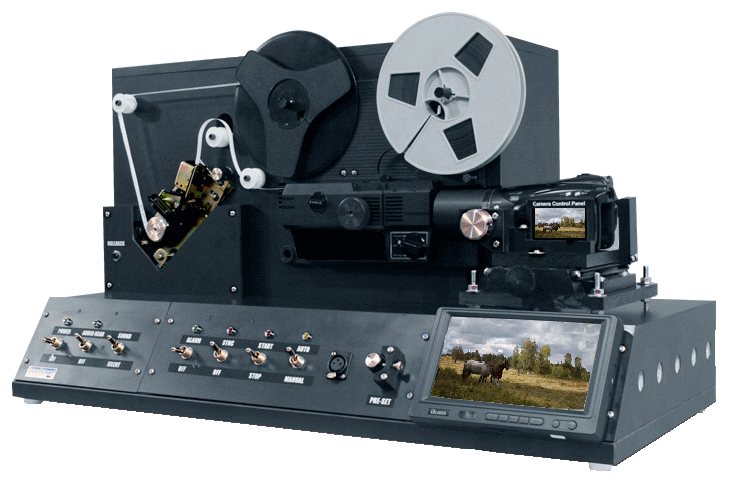
telecine – (1) The process of transferring motion picture film into video. (2) The equipment that converts a motion picture, captured originally on film stock, into video. Abbreviated as TK, since TC is used to refer to timecode.
Telecommunications Industry Association (TIA) – an organization created in 1988 when the U. S. Telecommunications Suppliers Association (USTSA) merged with the Information and Telecommunications Technologies Group of EIA (EIA/ITG). The TIA works with the EIA to develope technical standards and to collect market data for the telecommunication industry.
Telefunken – an electronics company, founded in Berlin, Germany, in 1903 as a joint venture of Siemens & Halske and AEG (Allgemeine Elektricitäts-Gesellschaft), creating Gesellschaft für drahtlose Telegraphie System Telefunken (The Company for Wireless Telegraphy, Ltd.). The joint venture was a compromise solution to a dispute over radio transmitter patents. Since then, Telefunken has operated under various versions of the name. Its product line has included radio transmitters, vacuum tubes, home electronics, appliances, and many others. During the 1940s and 1950s, Telefunken sold and distributed several microphones under its name for other companies such as Neumann and AKG, but they never manufactured any microphones during that period. Telefunken USA was formed in 2001 to repair and restore vintage Telefunken microphones, as well aS the buiding of reproductions. In 2009, Telefunken USA was renamed Telefunken Elektroakustik, and was given the exclusive rights to manufacture vacuum tubes and professional audio products under the Telefunken trademark in over 27 countries. Sometimes called by the nickname T-Funk.
Telefunken ELA M 250/251 – a tube condenser microphone manufactured from 1959 to 1962. In 1958, when Berlin-based Neumann stopped distributing the U 47 to the US under the Telefunken name, Telefunken needed a replacement microphone. AKG agreed to supply them a re-designed C 12, which was marketed as the ELA M 250 and the ELA M 251. However, whereas the C 12 polar patterns could be changed remotely by varying the polarizing voltage, the ELA M models used switches. The 250 had omni and cardioid patterns, while the 251 had omni, cardioid, and figure 8. The ELA Ms were also slightly different from the C 12 in their circuitry, as well as their head grilles. In 2003, Telefunken USA recreated the ELA M 251. This mic is handmade in the USA, using capsules that are handmade to original specs, transformers custom-made to original specs, and other exact parts. The main difference is the multi-pin connector on the mic cable to the power supply has been updated to a 6-pin XLR.
Telefunken U 47 – see Neumann U 47.
telephone filter – an equalization curve designed to simulate the sound of a voice on a telephone by removing frequencies below 300 Hz and above 3,000 Hz.
telephone jack – see phone jack.
telephone plug – see phone plug.
telerecording – British term for a kinescope.
telescoping shield – a configuration of a balanced cable in which the shield is connected only at one end. Shielding does not necessarily have to be connected a both ends to be effective. Typically the shield is left unconnected at the source, but some engineers prefer to disconnect the other end. The end left unconnected is said to be floating.
Teletronix Engineering Company – a company founded by James F. Lawrence II in Pasadena, California in the early 1960s. In 1965 Teletronix was sold to Babcock Electronics of Costa Mesa, California. In 1967 United Recording Electronics Industries (UREI), purchased the broadcast division from Babcock, which included the Teletronix brand. UREI also had acquired National Intertel, which became the Teletronix division. See Universal Audio for more details.
Teletronix® LA-2A Leveling Amplifier – a leveler designed by James F. Lawrence II, founder of the Teletronix Engineering Company, and introduced in 1965. Lawrence created the first leveling amplifier (hence the initials LA) utilizing optical sensors, by combining a luminescent panel with photo resistors (the impedance of which changes with light intensity) inside a vacuum-tube-sized metal tube. This optical attenuator produces a gentle, program-dependent optical compression, still revered by audio professionals. The LA-2A went out of production in 1969, returning for a couple of short production runs before being reissued by Universal Audio in 2000. The LA-2A was inducted into the TECnology Hall of Fame in 2004.
Teletronix® LA-3A Audio Leveler – a compressor introduced in 1969 by Teletronix that was essentially a solid-state version of the LA-2A, that incorporated components and design concepts of the solid-state Universal Audio 1176LN Limiting Amplifier, but retained the optical compression of the the LA-2A, resulting in the LA-3A having its own distinctive sound and versatility. Among other differences, the LA-3A has a faster response, but the LA-2A is more colored and somewhat warmer due to the tube effect. Production of the LA-3A ended in 1981.
television – (1) The broadcasting of pictures and sound using radio waves. Also called TV (US) or telly (UK). (2) A television set. (3) The television broadcasting industry and/or television media.
television-band device (TVBD) – an unlicensed radio frequency device that operates in the vacant channels or white spaces between US television channels in the range of 54 to 698 MHz. Also called a TV-band device or white space device.
television interference (TVI) – a type of RFI that interferes with the transmission and reception of television signals. Both natural and man-made phenomena can disrupt the reception of television signals, including lightning and spark-generating equipment.
television network – see network, defintion #2.
television program – see television show.
television receiver – see television set.

Standard definition (L)
High Definition (R)
television set – An appliance used to receive television broadcasts. Also called a television, television receiver, TV, TV set, or telly (British).
television show – a program intended to be broadcast on over-the-air, cable, or internet television. Also called a television program.
television station – an installation or organization used for the production and transmission of television broadcasts.
Telex Communications, Inc. – a manufacturer of hearing aids and audio equipment based in Burnsville, Minnesota, originally known as the Telex Corporation. In the 1970s it became Telex Communications, a subsidiary of Telex Corporation. In 1988, Telex was acquired by Memorex, and became Memorex Telex NV. In 1989 it was spun off as an independent company. It merged with Electro-Voice in 1998. In 2006, the company was acquired by the Bosch Group and became Bosch Communications Systems.
telly – (1) British slang for television. (2) Nickname for the Telefunken U 47, often used by Frank Sinatra. See Neumann U 47.
temperament – the arrangement of intervals and notes used to approximate a tuning system used for musical scales. The major temperaments that have been proposed and/or used in western music include Pythagorean tuning, just intonation, mean-tone temperament, harmonic series tuning, and equal temperament. See also intonation and Mathematics of Tuning and Temperament.
template – a DAW session file or project file that is pre-loaded with setups and configurations for a specific situation, but contains no audio or MIDI data. They are usually customizable and can be saved for a variety of situations to save time when creating new sessions. Also called a session template or project template.
tempo – the speed at which a piece of music is played, often measured in beats per minute (bpm). See also Metronome Marking .
tempo map – data providing the initial tempo and any tempo changes in a song as used by a MIDI device or digital audio workstation.
temporal – pertaining to time.
temporal blur – see temporal blurring.
temporal blurring – the smearing of transient information over time caused by digital filters. Temporal blurring affects the timing precision of sound. Also called temporal blur.
temporal masking – a condition in which a low level sound will not be perceived by the ear when it is adjacent to a much louder sound. If the loud sound precedes the soft sound, it is called forward masking. If reverse, it is called backward masking. Temporal masking can be used in the data compression of audio files using perceptual coding. Also called time masking or background masking.
temporary threshold shift (TTS) – an upward shift in the threshold of human hearing, which usually occurs as a means for the ear to protect itself when subjected to loud sound.
tempo rubato – see rubato.
tenor – (1) One of the highest vocal range of the adult male voice, usually a range from the C one octave below middle C to about A above Middle C (C3 to A4). (2) The musical range between alto and baritone. (3) A singer whose voice is within this range. (4) A musical instrument that plays within this range. (5) A vocal or instrumental part written in this range.
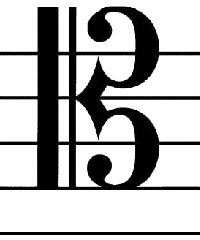
tenor clef – the symbol on a music staff indicating that the fourth line from the bottom of a staff represents the pitch of middle C. It is one of five C clefs and is used for writing music for the bassoon, cello, or tenor trombone.
tension rod – a bolt on a drum that goes through the holes in the rim and screws into a threaded lug attached to the drum shell used to to tighten and tune the drumhead.
tenuto – a notation that indicates a music note should be held for longer than its normal value, shown by a short, heavy line above or below the note.
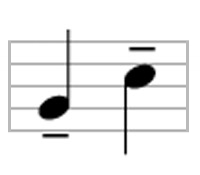
tera- (T) – the SI prefix for a factor of one quadrillion, 1,000,000,000,000 or (1012).
tercet – see triplet.
terminal – the connection at which a signal enters or exits an audio device.
terminal block – see terminal strip.
terminal board – see terminal strip.
terminal strip – a series of connectors, often made up of screw connections, arranged in a line used to permanently connect a number of lines between audio devices. Sometimes called a terminal block, terminal board, or barrier strip.

terminate – (1) To make a connection where a signal enters or exits an audio device. (2) A connection where an amplifier feeds a resistance that matches its impedance.
terrestrial radio – AM and FM radio stations that broadcast over the radio frequency airwaves, as opposed to internet radio.
terrestrial television – television stations that broadcast over the radio frequency airwaves, as opposed to cable television or satellite television.
tesla – a unit for measuring magnetic flux density. One tesla equals one weber per square meter.
tessitura – (1) The most musically acceptable and comfortable range for a given singer or musical instrument. (2) In musical notation, the range for a given piece of music, which is not determined by the extremes of its range, but by which part of the range is used most.
test acetate – see acetate.
test lacquer – see acetate.
test microphone – see measurement microphone.
test pressing – the first few copies of a vinyl record made from the initial stamper that is listened to and visually inspected to verify quality before going into the full production mode.
test tape – (1) A less formal name for an alignment tape. (2) During the production of magnetic recording tape, a reel of tape taken from a production run to check for quality control.
test signal – a signal or tone designed to test audio and video signals for various attributes, such as frequency, amplitude, phase, and others, as well as identification of channels and locations. See also test tone.
test tone – a tone with a predetermined level and frequency that is used to test or calibrate various audio devices. Sometimes called a reference tone or reference frequency.
TET – Tone Equal Temperament. See equal temperament. Also abbreviated as tET or tet.
tetrahedral array – see tetahedral microphone.
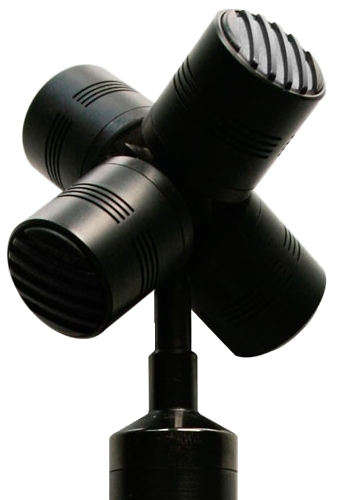
tetrahedral microphone – a microphone consisting of four closely spaced cardioid microphone capsules arranged in a tetrahedron invented by Michael Gerzon and Peter Craven. It can function as a mono microphone, a stereo microphone or as a surround-sound microphone. The microphone produces four signals, called the A-format that must be processed via software or hardware into a second set of signals called the B-Format. It is part of the Ambisonics surround sound technology, but is not exclusive to it. The first tetrahedral microphone was the SoundField microphone introduced by Calrec Audio in 1978. In 1993, the SoundField division of Calrec was split off into SoundField Ltd., who owned the SoundField trademark, even though soundfield is often used as a generic term. In 2012, SoundField was acquired by TSL Professional Products Ltd. In 2016, it became part of the Freedman Electronics Group the parent company of RØDE Microphones. RØDE redesigned the SoundField microphone and released it as the RODE NT-SF1. Sennheiser also markets a tetrahedral microphone, the Sennheiser AMBEO. Also called a ambisonic microphone or tetrahedral array.
tetrode – a vacuum tube having four active electrodes.
Texas Instruments, Inc. (TI) – an electronics company founded in 1951, and headquartered in Dallas, Texas, that designs and manufactures semiconductors and other products such as, calculators, microcontrollers, multi-core processors, and digital signal processors (DSPs).
T-Funk – see Telefunken.
THD – Total Harmonic Distortion.
THD+N – Total Harmonic Distortion + Noise.
theater – (1) A building, part of a building, or an outdoor area for the presentation of motion pictures (movie theater, dramatic presentations, or stage entertainment. See also home theater. (3) Dramatic arts as performances or a profession.
Theile trapezoid – see cardioid trapezoid.
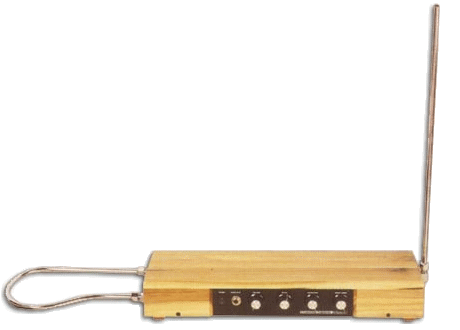
theremin – an early electronic musical instrument invented in 1928 by Russian inventor Leon Theremin. It consists of two metal antennas that sense the relative position of the performer's hands. The frequency is controlled by one hand and amplitude with the other without physical contact. The electronic signals are amplified and sent to a loudspeaker. Originally called an aetherphone, etherphone, thereminophone, termenvox, or thereminvox.
thermal – pertaining or relating to heat.
thermal equilibrium – the state in which electronic equipment has reached a steady, constant operating temperature for the environment it is in. Most audio equipment reaches thermal equilibrium in about ten minutes. During the startup/warmup period, swings in voltage, current, and temperature may occur and the equipment may not be operating at optimum performance.
thermal noise – the electronic noise caused by the thermal excitation of electrons in an electrical conductor, which occurs even when no voltage is applied. Also called Johnson noise, Nyquist noise, or Johnson-Nyquist noise.
thermionic tube – see vacuum tube.
thermionic valve – see vacuum tube.
THF – Tremendously High Frequency. The portion of the radio frequency spectrum from about 300 GHz to 3000 GHz. See the radio frequency chart.
thimble – see fingerpick.
thin – a descriptive term for a sound that is lacking in fundamentals as compared to harmonics, especially in the low end. Opposite of full or rich.
third – in music, the interval that includes three positions on the music staff. (See interval number.) A major third has a theoretical ratio of 5:4. However, in the equal temperament system, in which the notes are spaced equally, the ratio from middle C (262.63 Hz) to E4 (329.63 Hz) is 5:4.016, or about 14 cents wider than the 5:4 ratio. While a major third has an interval of four semitones, a minor third has an interval of three semitones, a diminished third has two semitones, and an augmented third has five.
third-harmonic distortion – a means to determine the maximum output level (MOL) of analog magnetic recording tape. MOL is defined as the magnetization level at which a recorded 1-kHz sine wave reaches 3% third-harmonic distortion.
third-octave – frequencies spaced every three octaves apart. For example, the third-octave above 1 kHz is 8 kHz. It should not be confused with one-third octave.
Thomson, Inc. – a company headquartered in Issy-les-Moulineaux, France, that provided provides services and products for the communication, media, and entertainment industries. In 2010, the company changed its name to Technicolor SA, after its American film technology subsidiary, with the US subsidiary becoming Technicolor USA, Inc. Formerly known as Thomson Consumer Electronics or Thomson Multimedia, the company has existed under several names, including Compagnie Francaise Thomson-Houston (CFTH), Thomson-Houston-Hotchkiss-Brandt, Thomson-Brandt, and Thomson-CSF. In 1988, Thomson bought the rights from GE to make and sell RCA, ProScan, and GE-branded televisions and other consumer electronics products. In 2004, Thomson formed TTE, a joint venture with China's TCL, allowing TCL to manufacture RCA and Thomson television and DVD products, although Thomson continued to control those brands, licensing them to TTE. In 2010, Thomson sold the RCA brand to ON Corporation.
three-channel stereo – an early version of stereophonic sound developed in 1933 that had three separate channels, designed to be reproduced with three speakers (left, center, and right). Also called three-track stereo.
three-head – a tape machine with separate erase, record, and play heads.
three-point edit – an audio edit in which the the beginning and ending points of the source audio are specified and only the beginning of the insert point (on the same or a different track) is specified. Typically, 3-point edits are used to insert new material into an existing track, with the material at the insert point either being replaced or pushed farther back in the time line. See also four-point edit and replace edit.
three-quarter-wavelength null – see ¾-wavelength null.
three-spaced-microphone technique – A stereo microphone technique using three microphones. The most common of these is the Decca Tree. See also wall of sound, definition #2.
three-to-one rule – see 3-to-1 rule.
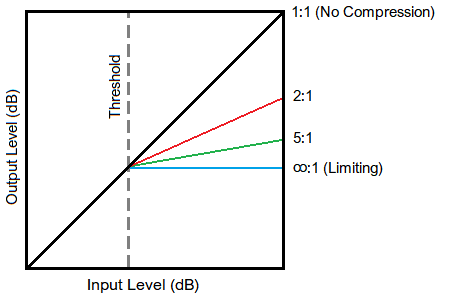
three-track mix – see 3-track mix.
three-track stereo – see three-channel stereo.
three-way speaker system – see 3-way system.
threshold – the level at which a signal processor begins to act upon a signal. Threshold controls are especially common on compressors, limiters, expanders, and gates.
threshold of audibility – see threshold of hearing.
threshold of feeling – the sound level at which a person can feel sound vibrations on the skin. This varies with frequency and decreases sharply for frequencies above 1000 Hz. This is the way that deaf people are able to perceive music.
threshold of hearing – the lowest sound level detectable by a person with good hearing, defined as 0 dB-SPL or 20 μPa. Also called the threshold of audibility.
threshold of pain – the sound level at which a person begins to experience pain, typically in the range of 120 to 140 dB-SPL.
throne – see drum throne.
through-zero flanging – see zero-point flanging.
throw – the maximum distance that a diaphragm will move in a microphone or speaker.
throw-out spiral – see lead-out groove.
Thru box – a device that provides multiple MIDI Thru signals for a single MIDI input.
thumb drive – see USB flash drive.
thumb picking – see fingerpicking.
Thunderbolt™ – an interface standard developed by Intel and released in 2011 that provides a means of connecting external peripherals to a computer. Using the same connector as a Mini DisplayPort (MDP), Thuderbolt 1 combines a PCI Express (PCIe) and a DisplayPort (DP) into one serial signal along with a dc power connection. Thunderbolt 2 provides the same 20 Gbps as Thunderbolt 1 but does so over a single channel, rather than 10 Gbps on two channels. Thunderbolt 3 uses a USB-C connector with a bandwidth of up to 40 Gbps, uses half the power consumption of Thunderbolt 1 and 2, and provides up to 100 watts of power. Thunderbolt 3 can connect not only to Thunderbolt-aware devices but also to older protocols, such as HDMI and FireWire using adapters. Thunderbolt 3 can also connect to USB devices. Although Thunderbolt 4 has the same high-speed 40-Gbps bandwidth as Thunderbolt 3, the speed for PCIe data increased from 16 Gbps to 32 Gbps, so that external PCIe devices like storage and external graphics should have a significant increases in transfer rates and performance. Thunderbolt 4 also has a wake from sleep feature, that allows a PC to be brought out of hibernation by peripherals that are connected through a dock. See also USB PD.
THX® – Tomlinson Homan's eXperiment. A trade name for a set of playback performance standards developed by George Lucas of Lucasfilm that components and systems must meet to be THX-certified. Originally intended for movie theaters, the standard has been expanded to include other items such as screening rooms, home theaters, computer speakers, and audio systems.
THX, Ltd. – a company founded in 1983 by George Lucas and headquartered in San Francisco, California, that develops the THX reproduction standards for movie theaters, screening rooms, home theaters, computer speakers, gaming consoles, car audio systems, and video games. Originally a subsidiary of Lucasfilms, Ltd., it was acquired by Creative Technology in 2002. In 2016, THX was acquired by videogame hardware company Razer, Inc.
THX Surround EX – a surround sound format that matrix-encodes a third surround channel into the existing left and right surround channels of a Dolby Digital signal that is used to drive a center rear speaker. See also DTS-ES.
TI – Texas Instruments.
TIA – Telecommunications Industry Association.
tick – a subdivision of a quarter note. MIDI systems often use a resolution of 480 parts per quarter note (PPQN) and each part is called a tick.

tie – a musical symbol consisting of a curved line used to join together two notes of the same pitch to combine their durations. It is similar to the slur, which is used to join together notes of different pitches to indicate a smooth transition from one note to the other.
tie line – a cable used to connect to one or more locations, such as between the studio and the control room.
tight – (1) A descriptive term for a sound that is well damped with rapid decay. (2) A recording made using close miking with the instruments well isolated. Also called tight miking. (3) Well synchronized playing of instruments.
tight miking – see tight, definition #2.
tilt – (1) A linear frequency response curve that is not horizontal, but that has an response that increases or decreases uniformly with increasing frequency. (2) To aim the axis of a loudspeaker upward or downward.
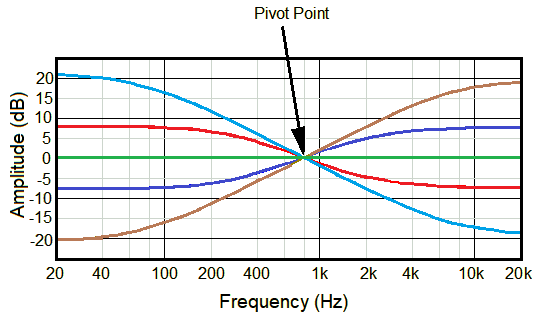
tilt equalization (EQ) – an equalization scheme consisting of an upper shelf and lower shelf meeting at an axis point or pivot point. When the upper shelf is boosted, the lower shelf is cut by the same amount and vice versa. So one control will cut the lows and boost the highs or cut the highs and boost the lows equally.
TIM – Transient InterModulation distortion.
timbre – (1) The quality that defines the sound that an instrument makes—what makes one instrument sound different from another even when playing the same note at the same volume. Timbre is primarily determined by the harmonic content and the dynamic characteristics of the sound, as demonstrated with an ADSR envelope. (2) The overall sound quality of a loudspeaker system. For example, some speakers have a warm timbre while others have a bright timbre. In a surround sound system all speakers should have a close timbral match for the best performance and sonic realism. Pronounced “tam-ber” or “tam-bra.” Also known as tone color or tone quality.
time – (1) Short for time signature. (2) The tempo of a song, usually expressed in beats per minute (bpm). (3) The length of a song, usually expressed in minutes and seconds.
time-aligned – see time-coherent.
timebase – a synchronization signal that is coordinated with the song tempo in a DAW, MIDI device, or sequencer. See also clock.
time-based distortion – distortion that occurs in the time domain. Examples include phase shift, wow, flutter, echo, and reverberation.
time-based effects – see time-domain effects.
timebase ruler – see ruler.
timecode – a timing and syncronization signal that occurs at regular intervals used for synchronizing various software-based audio systems. Almost universally used as the standard is the SMPTE/EBU time code, which is used in motion picture, video, and audio recordings (with audio standards set by SPARS). They can be encoded in many different formats, including linear timecode (LTC), vertical interval timecode (VITC), AES3 embedded timecode (used with digital audio), burned-in timecode, control track longitudinal timecode (CTL), and MIDI timecode (MTC). Also spelled time code.
timecode address – a specific reference or point in a time code, expressed in hours:minutes:seconds:frames.
timecode generation – the process of creating a new time code.
time-coherent – the character of a loudspeaker in which all audible frequencies reach the ear of the listener at the same time. However, most crossovers create a small amount of delay so that the sound from each driver arrives at slightly different times, causing a phase-shift. There is some debate as to the importance of time-coherence, especially since as the crossover cutoff slope increases, it decreases the amount signal going to the wrong driver, but also increases the delay. Also called time-aligned, phase-coherent, or minimum-phase speaker design.
time constant (τ) – (1) The time representing the speed with which a particular system can respond to change. For example, for an RC circuit, it is equal to the product of the resistance (in ohms) and the capacitance (in farads) of the circuit, or τ = R × C. (2) An RC circuit also acts as a lowpass filter and can be used to filter out high-frequency noise. The formula for a filter cutoff frequency (fc) is fc = 1/(2 × π × τ). The higher the value of time constant, the lower the corner frequency. Also called an RC time constant. Some common time constants found in audio applications are shown in the table below:
| Time Constant, τ (μs) |
Cutoff Frequency, fc (Hz) |
Equalization Emphasis | 17.5 | 9095 | IEC2/NAB |
|---|---|---|
| 25 | 7958 | Dolby FM |
| 35 | 4547 | DIN/IEC1 |
| 50 | 3183 | IEC2/NAB/FM |
| 70 | 2273 | Type 1 Cassette (Normal Bias)/IEC1 |
| 75 | 2122 | RIAA/Standard FM |
| 90 | 1768 | IEC2/NAB |
| 120 | 1326 | Type 2 Cassette (High Bias)/IEC2 |
| 318 | 500 | RIAA |
| 3183 | 50 | RIAA |
| 7958 | 20 | RIAA |
time delay – (1) The interval of time between two events. (2) The amount of time required for a signal to pass through a circuit, process, device, or medium. (3) The amount of time between the sending and receiving a signal. (4) The amount of time between applying power to a circuit or device and when it begins to operate. Also called timing delay, time lag or lag time.
time-difference stereo – using two microphones spaced at some distance apart so that time of arrival provides the primary stereo information. Also called time-of-arrival stereo or difference-in-time stereo. See intensity stereo and stereo microphone techniques.
time domain – time used as an independent variable in the analysis or measurement of time-dependent systems, functions, or signals. For example, a time-domain graph shows how a signal changes over time. See also frequency domain.
time-domain effects – those effects that change the time characteristics of an audio signal, such as delay, reverb, and phasing. The other two categories of effects are dynamic effects, which affect the gain of an audio signal, and spectral effects, which affect the frequency. Also called time-based effects.
time expansion/compression – to change the speed of a recording without affecting the pitch. Also called time stetching.
time lag – see time delay.

timeline – a ruler or ribbon running along the top edge of a DAW indicating the time (in bars and beats, minutes and seconds, samples, or other units) at which events in the project occur.
timeline marker – see marker.
time masking – see temporal masking.
time of arrival – see interaural time difference.
Time-Sensitive Networking (TSN) – a set of technical standards developed by the IEEE Time-Sensitive Networking Task Group (formerly the Audio Video Bridging Task Group) of the IEEE 802.1 standards committee, that provides specifications to allow time-synchronized low-latency audio and video streaming services through IEEE 802 networks. See also Audio Video Bridging.
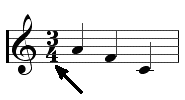
time signature – a musical notation written as a fraction on the musical staff in which the numerator specifies the number of beats in a measure and the denominator specifies what note equals one beat. For example, 3/4 time indicates there are 3 beats per measure and a quarter note equals one beat. Also called meter signature, metre signature, bar signature, or measure signature.
time stretching – see time expansion/compression.
timing delay – see time delay.
timing distortion – see intersymbol interference.
timing pulse – see synchronization signal.
timing resolution – see clock resolution.
timing signal – see synchronization signal.
timing tape – leader tape with markings every 7½ inches used to make precise, timed edits between selections.
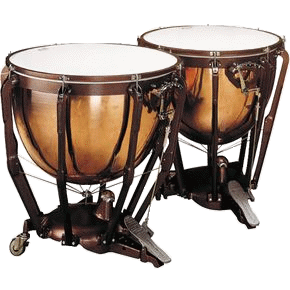
timpani – a set of tunable drums consisting of a skin stretched over a large bowl usually made of copper, played by striking the head with a special stick or mallet, and often used in orchestras. Although timpani is plural, the singular timpano is rarely used, but they are often incorrectly called timpanis. They are also called kettledrums. Sometimes spelled
tin flageolet – see penny whistle.
tin whistle – see penny whistle.
tinnitus – a medical term for the perception of sound occurring when no external stimulus is present. Although it is often called “ringing in the ears,” it is sometimes perceived as hissing, roaring, whistling, chirping, or clicking. While the cause is unknown, several conditions are known contributors including exposure to loud noises, wax build-up in the ears, some medications, infections of the ear or sinus cavities, and head or neck injuries.
tinny – a descriptive term for a sound with weak lows, boosted midrange , and very little upper frequencies upper frequencies, sounding like it came from a tin can or a telephone.
Tiny Telephone™ (TT) – a trademark of Switchcraft for a mid-sized phone plug that is 0.173 in (4.40 mm) in diameter (smaller than the ¼-inch phone plug, but larger than the 3.5 mm miniature plug). It is avalaible in both TS and TRS versions. Although they cannot handle as much power and are less reliable than a ¼-in plugs, they are sometimes used in studio patchbays and live sound applications to save space. Also known as a bantam jack.
TK – abbreviation for telecine.
TL – Transmission Loss.
TLA – (1) Transformer-Like Amplifier. A Rupert Neve design for a microphone preamplifier with lower distortion. (2) Three Letter Acronym. The origin of the term TLA is unsure, but some say it was invented by NASA.
TM – TradeMark.
TMA – The MIDI Association.
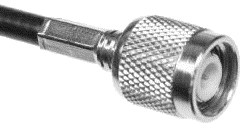
TNC – Threaded Navy Connector. A connector for coaxial cable similar to the BNC, except it screws on rather than twists on, providing a more secure connection.
TOC – Table of Contents.
token – see USB flash drive.
tom – short for tom-tom.
tom-tom – a cylindrical drum with no snare that is typically tuned to a certain pitch and may have heads on one or both ends. They come in a wide range of sizes for various pitches as well as mounting options, such as a rack tom and a floor tom. Called a tom for short.
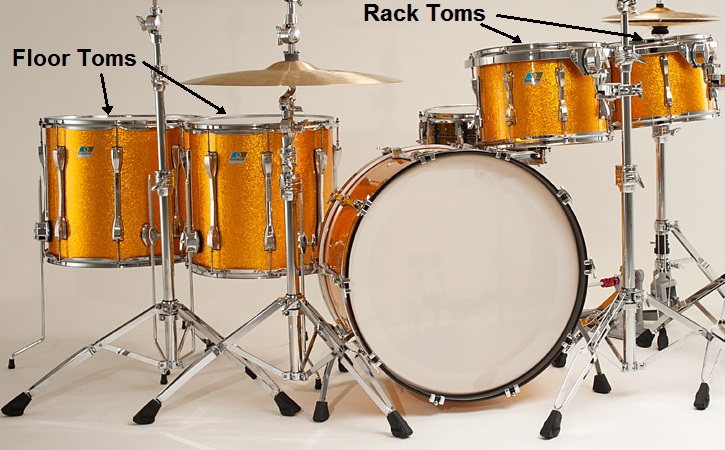
Tonader powering – see A-B powering.
tonal – (1) Pertaining to tone. (2) Music having an established key. The opposite of atonal.
tonal balance – (1) The volume relationships between different regions of the audio spectrum. (2) Having equal levels across the entire audio spectrum. (3) The degree to which one band of the audio spectrum is emphasized more than the others, typically described with terms such as warm, dark, or bright.
tonal center – see tonal harmony.
tonal harmony – music that (1) uses major and minor keys, (2) uses a functional harmony, and (3) has a tonal center (tonic or root note). With tonal harmony every chord has a function, categorized as either predominant, dominant, or tonic. The function of a predominant chord is to get you to the dominant chord, and the function of a dominant chord is to get you to the tonic chord. The tonic chord is the tonal center, the tone of complete rest and stability, the target toward which other chords lead (resolve). Tonal chord progressions tend to move via the circle of fifths. Also called tonality. Compare with modal harmony.
tonality – see tonal harmony.
tone – (1) An interval in music consisting of one whole-step or two half-steps (semitones), such as from from C to D. Also called a whole tone or whole step. (2) An audio signal of a particular pitch. (3) The timbre of a musical sound. (4) A musical note.
tonearm – the arm of a phonograph or turntable that supports the stylus and pickup allowing the stylus (needle) to follow the record groove.
tone color – see timbre.
tone control – (1) An electronic circuit typically found on consumer audio devices that allows you to adjust the bass and treble of the sound using shelving curves. (2) A slang term for an equalizer.
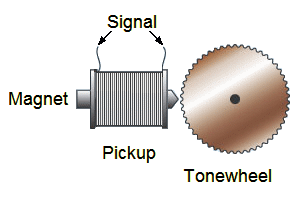
tone generator – see signal generator.
tone quality – see timbre.
tone track – a properly labeled track included with other music tracks that has a test tone that has been recorded at the nominal level used to produce the music tracks. For example, the tone track may include a 1,000-Hz tone recorded at -14 dBFS. It can be used by a mastering engineer to set the desired level of the music tracks.
tonewheel – a device used to generate musical tones in instruments such as electronic organs. It was invented about 1910 by the German engineer Rudolph Goldschmidt (not by Laurens Hammond as some claim). A tonewheel consists of an electric motor that rotates a series of metal disks, with each disk having a given number of notches or bumps on the rim. As these disks rotate within a magnetic field, they cause fluctuations in the magnetic field and generate a signal whose frequency depends on the rotation speed and the number of bumps. The signal is amplified to drive a loudspeaker. Sometimes called a tonewheel generator. Also spelled tone wheel.
tonewheel generator – see tonewheel.
tonic – the first note or first degree of a diatonic scale. It is called “tonic” because it is the tonal center or final resolution tone commonly used in classical, popular, and traditional music. Scales are named base on the tonics. For example, the tonic of the C scale is the note C. A tonic chord is the triad formed using the tonic pitch along with other notes of the same diatonic scale. The tonic chord is usually symbolized by the Roman numeral I (a major chord) in a major scale or i (lower case indicates that the chord is a minor chord) if it is in a minor scale. The tonic is sometimes confused with the root, which refers to the base note of a chord, rather than to that of the scale. Also called the keynote. See also supertonic, mediant, subdominant, dominant, submediant, leading tone, and octave.
tonicization – in music, treating a note other than the tonic (home note) as the temporary tonic. A dominant chord, especially a dominant seventh, sounds like it resolves or leads to the tonic. A tonicized chord is a chord other than the tonic chord to which a dominant or dominant seventh chord progresses. When a dominant chord or dominant seventh chord is used before a chord other than the tonic, it is called a secondary dominant. A tonicized chord makes a non-tonic chord sound temporarily like a tonic chord.
top – (1) The beginning of a song or audio file, as opposed to the tail or ending. Also called the head. (2) The front face of a guitar body. The top of an electric guitar may have a separate layer of wood (called a cap) most commonly made of maple. The cap contributes brightness to the tone of the guitar. The top of an acoustic guitar consists of a thin sheet of solid or laminated wood that resonates with the strings providing the primary tone of the guitar. Spruce, cedar, and other woods are commonly used for the top. Caps are not used on acoustics because they inhibit the resonance, causing a duller tone. Tops can be flat (flat-top guitar) or curved (archtop guitar).
top-address – see end-address.
top head – see batter head.
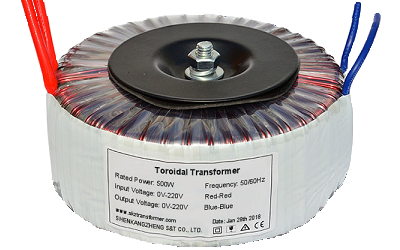
Toroidal Transformer
topping and tailing – the process of removing silence or extraneous sounds at the beginning (top or head) and end (tail) of a song in preparation for creating a master. In some cases this process may involve adding a fade in or fade out.
toroid polar pattern – see toroidal polar pattern.
toroidal transformer – a transformer that has toroidal (doughnut-shaped) core on which the primary and secondary coils are wound. The unique shape of the toroidal transformer allows for shorter coils, lower resistive losses or winding losses, improved efficiency, and a smaller external magnetic field.
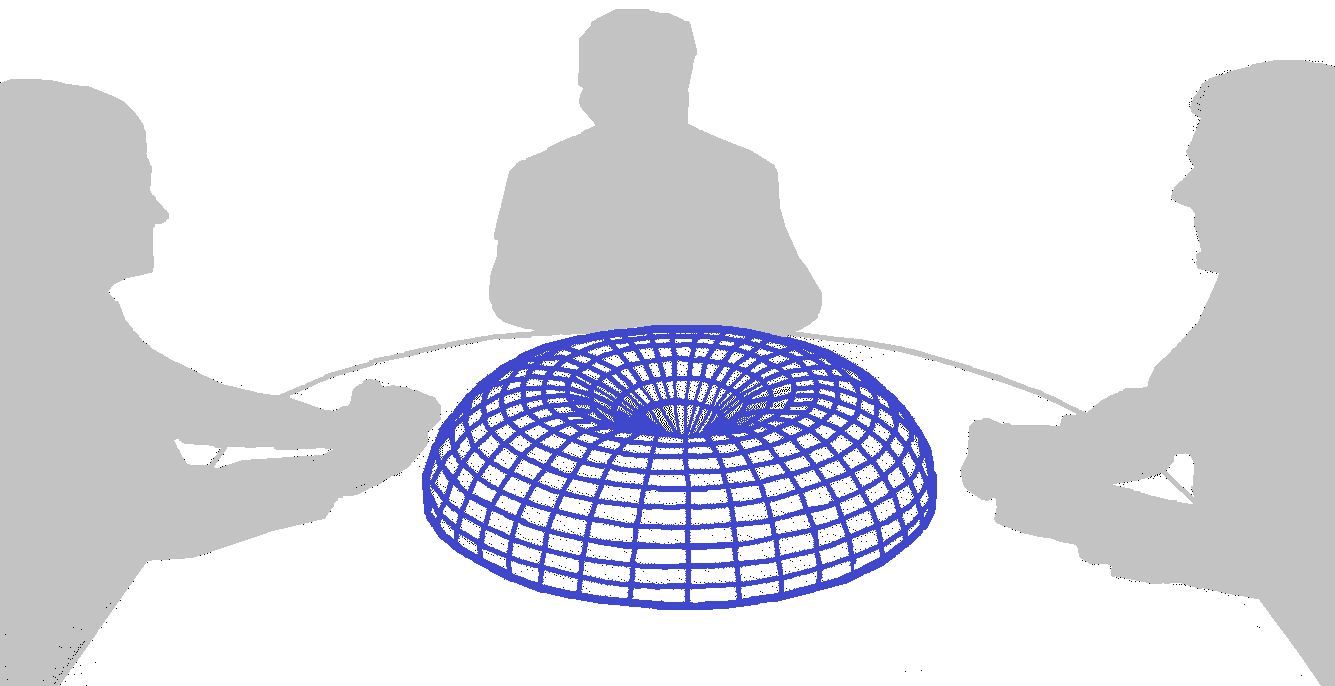
toroidal polar pattern – a microphone polar pattern shaped like a doughnut. In mathematics, a toroid is a surface of revolution with a hole in the middle, like a doughnut. If the surface that is rotated is a rectangle, it produces a hollow rectanglar ring. A revolved circle produces a doughnut-shaped object called a torus. Such a polar pattern is useful in teleconferences where it is more sensitive to participants gathered around a conference table than the noise coming from the center of the ring, such as projectors and other equipment. Also called a toroid polar pattern.
torque-limit switch – a control on a tape machine that adjust the torque (rotational force) to the reel motors according to the size of the tape reels in use.
torr – a unit of atmospheric pressure equal to the pressure that will cause a column of mercury (Hg) in a barometer to rise to a height of 1 mm. This was formerly indicated as 1 mm Hg, but has been replaced by the torr, named after Evangelista Torricelli, the Italian physicist who invented the barometer. One atmosphere equals 760 torr or 14.696 psi.
Toshiba Corporation – a multinational engineering and electronics corporation headquartered in Tokyo, Japan, that produces communications equipment, electronic components, power systems, household appliances, medical equipment, office equipment, and other products.
TOSlink – Toshiba link. The digital communication standard developed by Toshiba for the optical transmission of S/PDIF-formatted data for use with consumer and semi-pro equipment. Although several connectors can be used, the rectangular EIAJ/JEITA RC-5720 (also known as CP-1201 or JIS C5974-1993 F05) connector is the most common. The original S/PDIF connection used copper cables. Officially known as EIAJ Optical Standard.
total harmonic distortion (THD) – a measurement of the harmonic distortion in an audio signal, representing the cumulative level of all harmonic overtones that is added to the fundamental frequency. It should be noted that the amount of harmonic distortion varies by frequency and signal level. THD can be measured as a dB level below the input signal or as a percentage of the signal. This relationship can be seen in the chart below:
Total Harmonic Distortion (THD) |
|
| dB | Percentage |
|---|---|
| 0 dB | 100% |
| -10 dB | 30% |
| -20 dB | 10% |
| -30 dB | 3% |
| -40 dB | 1% |
| -50 dB | 0.3% |
| -60 dB | 0.1% |
total harmonic distortion plus noise (THD+N) – a measurement taken by inputting a sine wave into a device, notch filtering the output, and comparing the ratio between the output signal with and without the sine wave. This measurement is more comparable between devices than THD.
touch – see two-handed tapping.
touch-style – see two-handed tapping.
touchstyle technique – see two-handed tapping.
TP – True Peak.
T-Pain effect – see Cher effect.
T-pad – a type of electronic attenuator circuit with a schematic in the shape of the letter “T.” A T-pad maintains a constant impedance on both the input and output as the attenuation is changed. An L-pad holds either the input or the output impedance constant. An H-pad performs the same function as a T-pad, except it is designed for balanced lines. All three attenuate signals independent of the frequency. They are called pads because they “pad” down the signal analogous to acoustics. Also spelled T pad.
T-powering – see A-B powering.
TPQ – Ticks Per Quarternote. See PPQN.
TR – Turns Ratio.
TR-808 – short for the Roland TR-808 Rhythm Composer.
TR-909 – short for the Roland TR-909 Rhythm Composer.
track – (1) To record the individual channels of a multitrack recording. (2) To be controlled by or follow another signal proportionally. (3) A path or lane on a magnetic recording tape containing a single channel of audio. Also called a channel. (4) An individual recording of one instrumental or vocal performance on a digital audio workstation, analogous to a tape track. (5) A sequence of controls in a sequencer, analogous to a track in a multitrack recording. (6) The finished mixed down stereo or mono recording. An album typically contains 10 to 14 tracks, sometimes called cuts or bands.
track alternative – see playlist, definition #3.
track armed – see record enable.
track assignment log – see track sheet.
track count – (1) The number of tracks used in a recording session. (2) The number of tracks present in a recording device, such as a multitrack tape recorder, DAW, or digital recorder. See also track limit and channel count.
tracker – a type of music sequencer software for creating digital music. It provides for the creation of music with sound samples and synthesized instruments. Notes, parameter changes, effects, and other commands are entered into a spreadsheet-like grid of codes consisting of text and hexadecimal digits, where the rows represent fixed musical steps and the columns represent channels. Also called a music tracker.
tracker bar – see piano roll.
tracking – (1) The recording of a musical performance in either an analog or digial format. (2) The editing and assembly of the various tracks containing dialog, narration, sound effects, and music for a movie soundtrack, prior to re-recording. Also called track laying.
tracking error – (1) The difference in movement of a playback stylus in the groove of a vinyl phonograph record as compared to the movement intended when the master was cut with the stylus on the disc recording lathe. Such errors can lead to distortion, timing errors, and groove skips. (2) The difference in position of a playback head on a tape machine as compared to the position of the record head when a magnetic tape was recorded. Such errors can lead to distortion and signal loss.
track laying – see tracking.
track limit – the maximum number of tracks that a DAW can support. Track limit may vary by the type of tracks. For example a DAW may have limit of 256 audio tracks, but an infinite number of virtual tracks. See also track count.
track list – the list of songs appearing on an album, CD, LP, or other recorded medium. Also called a tracklist, tracklisting, or track listing.
track log – see track sheet.
track protection – a function found in some DAWs that allows you to protect or unprotect tracks from further changes or editing.
track sharing – using different places on a single track to record separately more than one instrument or voice. This was commonly done in the predigital era to save space on multitrack tape recordings, although it is occasionally done with DAWs for convenience.
track sheet – a chart onto which an engineer writes down information about each track of a recording. Also called a track log or track assignment log.
track template – a feature in some DAWs that allows you set up effects and other configurations for a track, similar to a session template, but for just one track.
track width – the width of a recording lane on a magnetic recording tape. The track width depends on both the width of the tape and the number of tracks it contains. For example, for a ¼-inch tape with four tracks, each track would be approximately 1⁄16 inch (¼ inch divided by 4). In actuality, they are slightly less than that to provide space between the tracks to prevent track overlap. See gap width.
trademark (TM) – a symbol, design, logo, emblem, sign, distinctive mark, word, or group of words established by use as representing a company or a product. A registered trademark is a trademark that a person or company has filed with the US Patent and Trademark Office and often carries the ® symbol.
trailer lead – see power strip.
trank – slang for transcription.
transaural audio – see transaural stereo.
transaural stereo – a binaural recording played through speakers rather than headphones, and processed to eliminate the crosstalk between ears (the signal from the left speaker being heard by the right ear and vice versa). A number of schemes have been devised for reducing the crosstalk, with some success. However, the process depends on the shape of the listener's head and being at the “sweet spot.” When done correctly it can come fairly close to the experience of binaural stereo without the use of headphones. Also called transaural audio or psychoacoustic surround sound.
transcode – to convert from one digital audio format to another, such as from MP3 to WMA. Transcoding is generally not recommended as it can degrade the audio quality of the file.
transconductance (gm) – an indication of the efficiency of a vacuum tube. It can be calculated using the formula gm = μ/rp, where μ is the amplification factor and rp is the plate resistance, expressed in microsiemens. It is also an indication of the useful life of a tube.
transcription – (1) In music, the conversion of music notation into tablature or some other form. (2) The adaptation of a musical composition. (3) A recorded radio or television program. (4) A transcription disc. Also called a trank (slang) or electrical transcription (ET). See acetate.
transcription disc – see acetate.
transducer – a device that converts energy from one form into another, such as converting sound into an electrical signal. Both microphone and speakers are transducers. Although many people do not realize it, speakers and microphones (in certain circumstance) can go both ways. That is, a speaker can be used to convert electricity into sound or sound into electricity. See speaker as microphone.
transduction – the process of converting energy from one form into another, such as the conversion of sound into an electrical signal. Tranduction is done by transducers, such as microphones and speakers.
transfer – (1) To copy audio or audio and video from one medium to another. The term transfer implies a change of medium as a transfer to the same medium is called duplication, copying, or dubbing. (2) The copy that results from this process.
transferabilitu – see translation.
transfer curve – see transfer function.
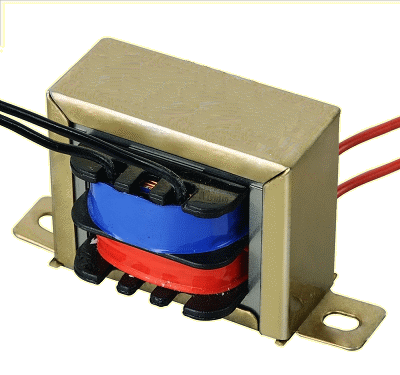
transfer function – a mathematical expression of the output of a device, such as a filter, based on the input, which determines the frequency magnitude response and phase response of the filter. When plotted as a graph, it becomes a transfer curve, a mathematical representation that describes those responses. Also called an input/output graph.
transformer – an electrical device that consists of two coils that are wrapped around a core so that they are magnetically coupled, used to convert from one voltage to another, except for isolation transformers, which usually have the same volatage in and out. Transformers used to convert from balanced to unbalanced lines are called baluns. Transformers are used in many pieces of audio equipment including amplifiers, preamplifiers, and microphones. Such transformers are carefully chosen because they can impart both good and bad distortion, such as various harmonics.
transformer balanced output – see balanced output.

transformer core – the solid magnetic material, usually iron or steel, inside a transformer, around which a coil of wire is wound, and which provides a path for the magnetic flux generated by the current flowing through the windings.
transformerless – a circuit frequently used in microphones that, instead of using a transformer for impedance matching, uses a semiconductor circuit.
transformer saturation – a situation in which a transformer core is producing its maximum magnetic flux, due to being undersized. This condition can adversely affect the tone of an amplifier and cause overheating of the transformer. Also called core saturation.
transient – a sharp spike in amplitude at the beginning of a waveform, such as that produced by a hammer hitting a string or a stick hitting a drum.
transient intermodulation distortion (TIM) – distortion that occurs when an audio device, such as an amplifier, cannot respond fast enough. In other words, the slew rate of the device is less than the actual rate of increase of a transient. Also called slew rate distortion.
transient response – the ability of an audio device to accurately respond to a rapidly changing input, such as that produced by a stick hitting a drum. Because a slow slew rate can result in poor transient response, the terms are sometimes used interchangeably.
transient smear – the sound that results from nonlinear phase shift (group delay) when the harmonics in a signal are delays by different amounts. Also called smearing transients.

transient voltage – a momentary change in voltage or current in the power grid that occurs over a very short period of time, typically 1⁄16 of a voltage cycle (about 3 milliseconds). Also called power surge, voltage spike, current spike, or simply spike.
transistor – a small electronic semiconductor device having at least three electrical terminals that can be used in a circuit as an amplifier, rectifier, switch, and other applications. It has essentially replaced the vacuum tube for most applications. It was invented at Bell Laboratories.
transitional bridge – see pre-chorus.
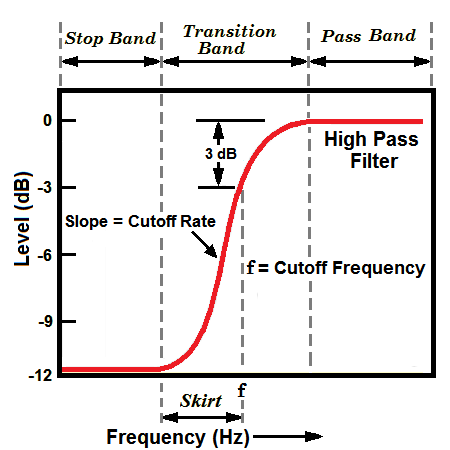
transition band – the range of frequencies, in the transition between a pass band and a stop band of a filter. The transition band is defined by the passband and stopband cutoff frequency. Sometimes called transition region.
transition frequency – see Schroeder frequency.
transition region – see transition band.
translatability – see translation.
translation – an indication of how well a studio mix will sound on consumer speakers, music players, and other playback devices on which it is likely to be reproduced. Sometimes called tranferability or translatability.
translator – see broadcast translator.
transmission – (1) The act or process of sending a signal using radio waves. (2) A message or broadcast that is sent using radio waves. (3) Sound transmission.
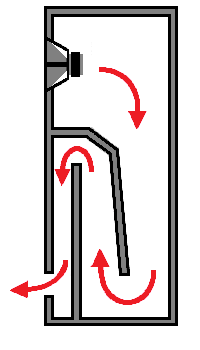
transmission line (TL) enclosure – a type of loudspeaker enclosure design that uses an acoustic transmission line within the cabinet. With this design sound waves emanating from the back of the bass driver pass into a long, usually folded and damped pathway within the speaker enclosure. This design uses speaker energy more efficiently, results in improved sound, and allows for greater sound control when compared to enclosures using sealed or ported designs. The pathway is usually lined with various types and amount of absorbent material, which both reduces reflection and resonance and reduces the speed of sound within the cabinet to allow for better tuning. The duct may vary in size or may taper and may be open or closed at the end. When properly designed, such enclosures absorb or reduce unwanted resonances and energies that can cause undesirable auditory effects, or cause low frequency sounds to emerge from the open end in phase with the sound radiated from the front of the driver, which enhances the low-frequency output. The result is increased efficiency and a low-frequency response that extends far below that of other speaker enclosure designs. However, their complex design tends to make them much more expensive than other designs.
transmission loss (TL) – (1) The loss in power of a signal as it travels from one point to another. Transmission loss in wires is due to resistance, inductance, and capacitance. Transmission loss with a wireless signal can be due passing through walls and other obstacles (absorption loss) or due to terrain. (2) Sound reduction.
transmit – (1) To send or broadcast a signal using radio waves. Abbreviated as TX, XMT, or XMIT. (2) To send an signal along an electric path. (3) To send a sound wave through a medium.
(4) To send a MIDI command to another device.
transmitter – (1) An electronic device that converts video, audio, and/or data signals into modulated radio frequency signals, and transmits them as electromagnetic waves. Transmitters range from small devices that send signals to a receiver within the same room to giant towers that disperse radio waves for many miles. Also called a radio transmitter. (2) An obsolete term for a microphone. Used in the early days of microphone development before the term microphone came into gemeral use.
transondent – allowing sound to pass through with no change. Transondency is to sound as transparency is to light. Pop filters and speaker grilles should be transondent.
transparency – (1) Having little to no tonal coloration in an audio signal. (2) The state in which a data compressed audio file has a sound that is indistinguishable from the original uncompressed file, with nonexistent or imperceptible compression artifacts.
transparent – (1) Minimual tonal coloration in an audio signal. (2) A data compressed audio file having a sound that is indistinguishable from the original uncompressed file. (3) A descriptive term for a sound that is clear and detailed. The opposite of muddy, veiled or opaque.
transponder – a wireless device that receives an incoming signal and automatically responds by transmitting its own signal. Transponders are used for communications, monitoring, and control and can be either passive or active. The term is a combination of the words transmitter and responder.
transport – the portion of a tape machine that moves the recording tape from the supply reel across the heads to the take-up reel. Also called a tape transport.
transportable mix – a term used to describe a mix that sounds good in various listening environments using an array of different playback systems.
transport control – (1) The controls on a tape machine that start, stop, fast forward, and rewind the recording tape. (2) The controls on a DAW analogous to the transport controls of a tape machine.
transpose – (1) To change a song from one key into another. See Chart of Common Instrument Transpositions. (2) In a digital audio workstation, to shift audio or a MIDI note up or down in pitch. Transposing audio is done with a pitch shifting plug-in, while transposing MIDI notes is done by moving notes in a MIDI editor.
transposition – the process of changing a song from one key into another. See Chart of Common Instrument Transpositions.
transverse wave – a wave in which the displacement of the medium is at right angles to the direction of propagation of the wave, as opposed to a longitudinal wave, in which the displacement of the medium is in the same direction as (or the opposite direction to) the direction of propagation. Sound waves are longitudinal.
transverse-wave resonating panel (TWRP or TRP) – a type of flat-panel loudspeaker that consists of a panel attached to transducer. An audio signal induces transverse waves in the panel, causing it to vibrate and propagate highly diffuse and incoherent sound waves. TWRPs transmit sound composed of transverse waves, not longitudinal waves like those produced by cone speakers. They are used to create Layered Sound™.
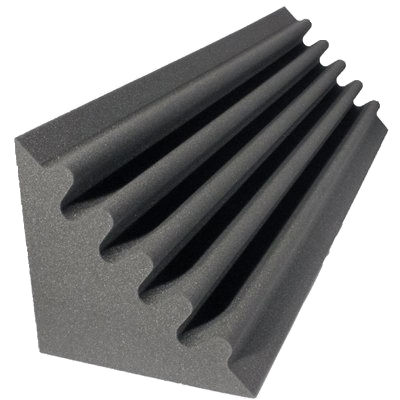
trap – a device that absorbs certain frequencies of sound, such as a bass trap, which absorbs bass frequencies.
trap kit – see drum kit.
trap set – see drum kit.
trash microphone – a slang term for a microphone placed in the center of a drum kit capturing the entire kit. The signal from a “trash” mic is often highly compressed and mixed with other mics for special effects.
treble – (1) The vocal range of children before they reach puberty, usually a range from about A below middle C to the F one and a half octaves above middle C (A3 to F5) or above. Traditionally choirs were made up of all boys and the term boy soprano was used for this vocal range. However, with many girls now singing in such choirs, the term is no longer accurate. (2) The musical range above soprano. (3) A singer whose voice is within this range. (4) The upper end of the audio spectrum. Also called treble frequencies.
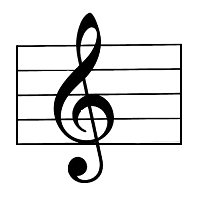
treble clef – the symbol on a music staff indicating that the second line from the bottom of a staff represents the pitch of G above middle C. Also called a G clef..
treble frequencies – see treble, definition #4.
tremolo – the smooth and repeated variation of amplitude of an audio signal. It is often confused with vibrato, which is a variation of pitch. Many guitar amplifiers incorporate tremolo, but few have vibrato, which is usually introduced with a guitar pedal. Guitar amplifiers usually create tremolo using either optical tremolo or bias-modulated tremolo.
tremolo arm – see tremolo bar.
tremolo bar – a narrow bar attached to the bridge of an electric guitar that can be raised or lowered to lower or raise the pitch by changing the tension on the strings. Also called tremolo arm or whammy bar.
tremolo picking – a playing technique consisting of rapidly and repeatedly striking a single note on a stringed instrument in a steady rhythm, a particularly common technique used on a mandolin.
triad – a set of three music notes each a third above the other. The members of the triad, from lowest pitched tone to highest, are called the root, the third, and the fifth. See also dyad.
TRIAD – Trident Audio Developments.
triamped – short for triamplified.
triamplified – using three amplifiers to power the three drivers within a single speaker cabinet. Called triamped for short. Sometimes spelled tri-amplified
triangle – a percussion instrument made from a bar of metal, such as steel or beryllium copper, bent into a triangular shape. It is struck with a wand.
triangle method – see Glyn Johns method.

triangle wave – a triangular shaped waveform consisting of steady rises followed by steady falls. See also sawtooth wave, sine wave, square wave, and ramp wave.
triangular probability density function – a probability function used as a method of dithering that results in a lower noise level following the dithering process.
triax cable – a cable similar to coax that has another layer of insulation and a second conducting sheath. It is more expensive, but it provides better bandwidth and greater RFI rejection.
triboelectricity – see triboelectric effect.
triboelectric charging – see triboelectric effect.
triboelectric effect – the creation of an electric charge in a material when it comes into frictional contact with another material. Rubbing glass with fur or running a plastic comb through hair can create triboelectricity. Most static electricity is caused by the triboelectric effect. Some electronic devices, such as some integrated circuits and transistors, can be damaged by accidental static discharge. Precautions must be taken to protect such devices by storing them in a conductive foam and by grounding yourself or standing on special mats before handling these devices. Also known as triboelectric charging.
Trident Audio Developments (TRIAD) – a manufacturer of recording studio consoles and other pro audio equipment, headquartered in Gardena, California. Their original consoles were designed and built for in-house use at the Trident Studio, a British recording facility that opened in 1967 in London. Trident Audio Developments was formed in 1971 when word spread about the new console design and other studios placed orders.
trigger – (1) To send a signal to a device to initiate an action. (2) The signal sent to to a device to initiate an action. (3) A signal sent by an cableanalog synthesizer when a key on the keyboard is pressed or released, as well as the signal generated by foot pedals, drum controllers, and other devices. Such synthesizers had two types of triggers: (a) voltage trigger (V-trig) and (b) switch trigger or shorting trigger (S-Trig). Today, most synthesizers use an on/off trigger called a gate. Typical gate voltages are +5 volts and usually (but not always) have a positive polarity or a switch to select polarity.
trill – a rapid alternation between a note and the note a half to one tone above it.
trim – (1) To make a small adjustment to a parameter. (2) The initial control on a mixer or console used to adjust the input level of a channel. Sometimes called gain trim, gain, sensitivity, or input level. (3) To remove a portion of an audio clip or region.

triode – a vacuum tube with three electrodes used for amplification. It consists of an evacuated glass tube with a heated filament (the cathode), a grid, and a plate (the anode).
triplet – a group of three music notes having the same time value of two like notes, indicated by a bracket over the notes with the number 3 above it. For example, a triplet of quarter notes would be played in the time allowed for two regular quarter notes. Also called tercet. See also tuplet.
tritone – an interval between musical notes that spans three whole steps, or six semitones. Two stacked tritones span one whole octave. The tritone is called an augmented fourth or diminished fifth, depending on its place in a chord or a musical key. The tritone is one of two strong dissonances in the diatonic scale.

trombone – a large brass instrument consisting of a long cylindrical tube curving on itself twice, ending in a wide bell, and having a movable U-shaped slide used to produce various pitches.
trough – see wave trough.
TRP – Transverse-wave Resonating Panel.
TRS – Tip-Ring-Sleeve. A type of phone plug used with balanced audio cables and for stereo signals to a headphone. See also TS.
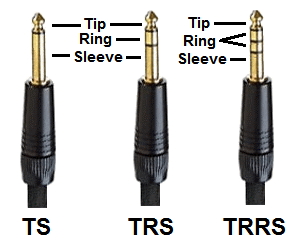
TRRS – Tip-Ring-Ring-Sleeve. A type of phone plug with dual rings similar to the single ring TRS connector. These connectors are used in audio/video to carry stereo audio plus a composite video signal. These cables are also used with Apple devices such as the iPad, iPhone, and iPod. See also TS and TRS.
True Audio – an audio file format for lossless audio data compression that reduces the file size by about 30%, but does not discard data during encoding, as opposed to lossy compression techniques such as MP3, AAC, and Vorbis. A digital audio file (such as a CD) that has been encoded with True Audio can be decompressed back into an identical copy of the original audio data. It uses the .tta file extension.
true bypass – the process of passing a signal directly from the input to the output of a processor. This is in contrast to regular bypass in which a signal still passes through the processing circuitry but the signal is unaffected by the processor. There is no latency in a true bypass, but not so for the regular bypass.
true diversity – a system used with wireless microphones to improve reception and minimize signal dropouts by automatically switching between two separate receivers and antennas depending upon which is receiving the stronger signal. See also diversity and antenna diversity.
true peak (TP) – the maximum peak value (which takes into account any inter-sample peaks) of an audio signal of a program using the ITU BS.1770 standard. It is usually higher than the sample peak value.
true peak meter – a meter that displays the absolute peak of an audio waveform as it will be heard once the digital audio has been converted back to an analog signal, taking into account any inter-sample peaks that may occur. See true peak.
true peak program meter – see true peak meter or peak program meter.
true power – see apparent power.
true response graphic equalizer – a graphic equalizer with output characteristics that exactly match the positions of the slide controls on the front-panels.
true stereo – (1) A recording made with usually two to three microphones using one of the stereo microphone techniques which captures level differences, timing differences, and phase differences that the human ear interprets as directional information, as opposed to panpot stereo. Such recordings can be made on two or more tracks, but are reduced to two stereo channels in the final mix. (2) A term used to differentiate a stereo recording, whether using either panpot stereo or true stereo techniques (see definition #1 above), from a one using simulated stereo. Sometimes called real stereo.

True Temperament Guitar
True Temperament™ – the trademark of True Temperament AB, a company in Stockholm, Sweden, for their method of using curved frets on guitars to compensate for the fact that the same note played on two different strings of a equal-temperament-tuned guitar will be off by a few cents. See also James Taylor tuning method.
trumpet – a brass musical instrument having a flared bell, tubing looped to form a straight-sided coil, and three valves. A cornet is similar to a trumpet, but it is shorter and wider, and is typically used in bands.
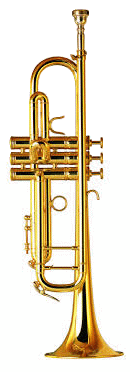
truss rod – a metal bar that runs through the neck of a guitar under the fretboard to counteract the tension exerted by the strings and to allow the curvature of the neck to be adjusted. Classical guitars do not require a truss rod due to the low tensile strength and high elasticity of nylon strings.
TS – Tip-Sleeve. A type of phone plug used with unbalanced audio cables, such a guitar cables. See also TRS and TRRS.
Ts and Cs (Ts & Cs) – the abbreviation for terms and conditions, the specific details that control a contract, agreement, arrangement, activity, or software.
TSN – Time-Sensitive Networking.
TT – Tiny Telephone.
.tta – file extension for the True Audio format.
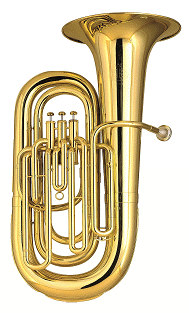
tuba – the largest and lowest-pitched of the brass instruments. The tuba has a conical bore, which causes the instrument to produce predominantly even-order harmonics. Tubas come in a variety of versions. A tuba that rests on the lap of the player is sometimes called a concert tuba. A tuba with the bell facing forward rather than upward is often called a recording tuba, because in the early days of the recording industry the sound could be directed at the recording device. A tuba that wraps around the body with the bell facing forward and used for marching is called a sousaphone, after John Philip Sousa, who used it in his marching bands. Sometimes called a bass horn or a brass bass (to distinguish it from a string bass).
tube – short for vacuum tube.
tube amplifier – a type of electronic amplifier that uses vacuum tubes to increase the amplitude or power of an audio signal. Most tube amplifiers were generally replaced by solid state amplifiers during the 1960s and 1970s, except for guitar amplifier. Also called a valve amplifier.
tube compressor – a type of audio compressor that uses a vacuum tube to compress an audio signal. This was the original compressor design. Tube compressors tend to have a slower response than other types of compressors, and have a distinctive coloration that is often called a “vintage” sound. That sound is nearly impossible to achieve with other compressor types. See also VCA compressor, FET compressor, optical compressor, variable-mu compressor, PWM compressor, digital compressor, low-level compressor, and multiband compressor.
tube distortion – a distortion of the audio signal when a recording is made with devices that use vacuum tubes. Vacuum tubes have a tendency to introduce even-ordered harmonics to the signal. The effect is very pleasing and is sometimes called “tube warmth”, “tube effect”, or “valve warmth” (British). Also called vacuum tube distortion or valve distortion (British).
tube effect – see tube distortion.
tube microphone – any microphone that uses a vacuum tube in its preamplication circuit. Such mics are said to produce warmer sounds.
tube saturation – see saturation.
Tube-Tech CL 1B Compressor – a classic optical compressor introduced in 1991, by Tube-Tech founder John G. Petersen. The CL 1B has gone on to become an industry standard found in pro studios worldwide. It is known for its velvety-smooth, musical-sounding compression while maintaining transparency.
tube warmth – see tube distortion.
tubby – a descriptive term for a sound with low-frequency resonance, sounding like it was coming from a bath tub. See bloated.
tubs – slang for drums.
Tuchel connector – a 3-pin or 5-pin microphone connector that was used on some early microphones, especially those manufactured in Europe. They were often called small Tuchel microphone connectors, but in the US they were known as DIN connectors. They were originally manufactured by the Tuchel company, which is now a division of Amphenol. These microphone connectors were essentially replaced by XLR connectors.
tumbadora – see conga drum.
tune – (1) To adjust the pitch of an instrument to match that of other instruments or to a standard such as a tuning fork, electronic tuner, or a standard such as A440. (2) To make adjustments on a radio receiver to receive a particular frequency or radio station. (3) A melody, particularly one that characterizes a song or a piece of music. (4) A song.
tuned – designed or adjusted to be most sensitive to a specific frequency or range of frequencies, such as a tuned circuit or tuned cavity.
tuned cavity – an enclosed space designed so that its physical dimensions will resonate at a particular frequency, reinforcing the energy at that frequency. A tuned acoustic cavity, designed with an opening so that the air within it vibrates, is known as a Helmholtz resonator.
tuner – (1) A device used to adjust an instrument to a particular pitch, such as a tuning fork, a pitch pipe, and an electronic tuner. (2) A thumbscrew or adjustable pin to which the strings of a stringed instrument are attached and used to vary the pitch. Also called a tuning peg. (3) An electronic device designed to receive incoming modulated radio waves and convert them into sound or data, such as a radio tuner or television tuner.
tuning – the process of adjusting the pitch of an instrument to match that of other instruments or to a standard such as a tuning fork, electronic tuner, or a standard such as A440.
tuning correction – see pitch correction.
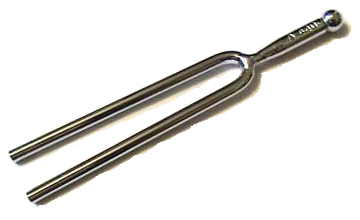
tuning fork – a two-pronged piece of metal that when struck emits the tone of a particular pitch.
tuning head – see headstock.
tuning peg – a thumbscrew or adjustable pin to which the strings of a stringed instrument are attached and used to vary the pitch. Sometimes called a tuner.
tuning system – in music the arrangement of notes (or tones) into various intervals to creates a pleasing sound. In western music, the twelve-note octave has become the predominant tuning system. However, it is impossible to arrange twelve notes so that all intervals are pure intervals, meaning they have simple ratios to one another and sound consonant. To ovecome this problem, various schemes have been devised to approximate the pure intervals, and these schemes are called temperaments. Although the terms tuning system and temperament are often used interchangeably, they are not exactly the same. The tuning system is the framework of notes and intervals, while the temperament is the method used to approximate that system. A tuning system should have perfect intervals, but since that is impossible, a temperament must be used.
tuning the room – see ringing out a room.
tuning the system – see ringing out a room.
tuplet – a rhythm with a given beat that is divided into a different number of equal subdivisions, such as duplets and triplets, usually grouped with a bracket with a number or numbers above it. Also known by many other terms, such as irrational rhythm, irrational groupings, artificial division, artificial groupings, abnormal divisions, irregular rhythm, gruppetto, extra-metric groupings, and contrametric rhythm.
turnaround – a passage at end of a section of music that leads to the next section, either harmonically (such as a chord progression) or melodically.
turnover frequency – see cutoff frequency.
turns ratio (TR) – the ratio of number of turns of wire in the primary winding of a transformer to the number of turns of wire in the secondary winding. The TR determines how much the voltage is stepped up or down by the transformer.
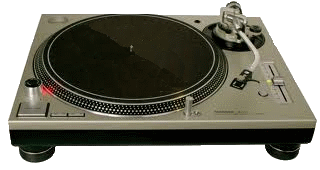
turntable – (1) A device used to playback a phonograph record, consisting of a disc or platter rotated by a motor, and a tonearm that contains a stylus and cartridge. (2) One of two round disc platters found on a tape machine that holds the tape reels in place, sometimes with a locking mechanism. Also called a tape disc.
turntablist – a person who uses turntables and a DJ mixer as a musical instrument to create music and sounds. The term is used to differentiate between a DJ who simply plays records and one who performs by manipulating the records, stylus, and mixer to produce sounds.
turntablism – the art of creating sounds and music by manipulating turntables and a DJ mixer. The person performing the art is called a turntablist.
TV – see television. See also telly.
TVBD – TeleVision Band Device.
TVI – TeleVision Interference.
TVS – Transient Voltage Suppressor. A class of devices designed to react to sudden voltage spikes or momentary overvoltage conditions to protect electronic circuits and equipment.

a. Cone
b. Dome
c. Ribbon
d. Electrostatic
e. Planar
f. AMT
TV set – see television set.
TV station – see television station.
tweak – (1) To trim. (2) (Slang) To calibrate, especially when done very precisely.
tweeter – the driver in a loudspeaker cabinet designed to produce the higher range of audio frequencies, typically from about 1,000 hertz (Hz) up to around 20 kilohertz (kHz). Three important properties for tweeters, especially for cone and dome tweeters, are low mass, high stiffness, and good damping. There are several types of tweeters. Cone tweeters have the same basic design as a conventional dynamic speaker. Cones are typically made of paper, silk, coated fabric, or ceramic. Cone tweeters were popular in the 1960s and 1970s, but
fell out of favor during the 1970s and 1980s with the introduction of higher quality audio, especially the compact disc, because the frequency response of cone tweeters seldom exceded 15 kHz. Developed in the 1950s, the dome tweeter began to replace the cone tweeter in the 1970s. The dome tweeter consists of a voice coil attached to a dome typically made of woven fabric or thin metal (aluminium, titanium, magnesium, or beryllium), with the magnet attached to a front plate instead of a frame or basket. A ribbon tweeter uses a diaphragm that consists of a very thin corrugated ribbon made of metal or metal-coated plastic film that is suspended in a magnetic field. The development of ribbon tweeters has paralleled the development of ribbon microphones. Planar magnetic tweeters (sometimes called quasi-ribbon tweeters) uses a thin piece of plastic film with a voice coil wire running numerous times vertically across it. They are generally less expensive than true ribbon tweeters. An electrostatic tweeter is similar to a full-range electrostatic speaker. It uses a thin plastic diaphragm with a thin conductive coating, suspended between two screens or perforated metal sheets, called stators. Because very high voltage is applied to the diaphragm, a step-up transformer is required. The air motion transformer (AMT) tweeter works by forcing air perpendicularly through a pleated diaphragm held in a strong magnetic field. They are capable of considerable output levels and are more sturdy than electrostatics or ribbons. A horn tweeter can be any of the above tweeters designs but is attached to a flared-horn structure. Horns help improve dispersion and increase efficiency. A piezoelectric tweeter contains a piezoelectric crystal attached to a diaphragm. Piezo tweeters are never used in high-end audio because of their low fidelity. Also called a high-frequency driver.
tweeter –
twelve-string guitar – a guitar having twelve steel strings in six courses. That layout creates a richer tone with more ringing than the standard six-string guitar. The strings within each course are close together so that each course is fretted and plucked together. Typically, the strings of the lower four courses are tuned an octave apart, while the upper two courses are tuned in unison.

twisted pair – two copper wires each covered with insulation that are twisted together. There may be multiple sets of twisted pairs within a single cable. The twisted pair maybe shielded, indicated as STP (shielded twisted pair), or unshielded, UTP (unshielded twisted pair).
twin-diode tube – a vacuum tube with two linked diodes to pass current, providing for two tube stages in a single vacuum tube. Also called a double-diode tube.
twittering – see birdies.
two-bus compression – see mix bus compression.
two-handed tapping – a guitar playing technique in which both the picking hand and fretting hand, either together or independently, tap the fretboard to sound notes. For example, the right hand can play the melody while the left hand plays the bass line. Two-handed tapping has become the basis for an entire genre of fingerstyle guitar playing. Also called the touch, touch-style, or touchstyle technique. See also one-handed tapping.
two-sided hit – see A side.
two-track – (1) A stereo recording using two tracks. (2) The same as half-track.
two-way radio – a radio that both can transmit and receive, unlike a broadcast radio that only receives programming. Two-way radios are used by amateur radio enthusiasts, as well companies and individuals that need a means to communicate. These devices often have a push-to-talk button to activate the transmitter. Somestimes called a transceiver. Hand-held portable two-way radios are called walkie-talkies or handie-talkies.
two-way speaker system – see 2-way system.
TWRP – Transverse-Wave Resonating Panel.
TX – one of several abbreviations for transmit.
Tyco – a company founded in 1960 as Tyco, Inc., an investment and holding company with two segments: Tyco Semiconductors and The Materials Research Laboratory. Over the years, it expanded through acqusitions, and in the 1980s, reorganized its subsidiaries into four segments: Electrical and Electronic Components, Healthcare and Specialty Products, Fire and Security Services, and Flow Control. It became Tyco International in 1992. In 2007, Tyco slit into three publicly independent companies: Covidien Ltd. (formerly Tyco Healthcare), Tyco Electronics, Ltd. (becoming TE Connectivity), and Tyco International, Ltd. (formerly Tyco Fire & Security and Tyco Engineered Products & Services (TFS/TEPS)).
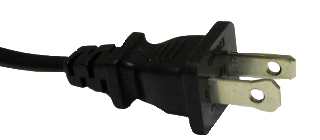
Tyco Electronics – see TE Connectivity.
tympani – see timpani.
Type I, II, III, and IV tape – see tape type.
type A plug – an ordinary household ungrounded electrical plug used in the US, North and Central America, and Japan having two flat blades (polarized versions having one blade larger than the other), but no ground pin. It was designed by Harvey Hubbell II in 1903. It is designated as American standard NEMA 1-15. Sometimes called a Hubbell plug. See also type B plug.
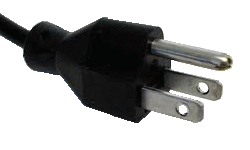
type B plug – an ordinary grounded household electrical plug used in the US, North and Central America, and Japan having two flat blades (polarized versions having one blade larger than the other) and a semi-round ground pin. It is designated as American standard NEMA 5-15. Also called a PBG (Parallel-Blade-Ground) plug, U-ground plug, or Edison plug. See also type A plug.
type B videotape – a professional 1-inch analog reel-to-reel magnetic tape format for video developed by Robert Bosch GmbH in Germany and introduced in 1976. This videotape format became the broadcast television standard in continental Europe, but had only limited use in the US and UK, where the type C videotape became the primary format. Type B videotape recorded video using two record/playback heads on a small head drum rotating at 9,000 RPM with a 190° wrap and had three longitudinal tracks, two audio tracks and one linear timecode (LTC) track. Unlike type C, the type B format required additional equipment to add functions, such as still, shuttle, and variable-speed playback. Also called B-format.
type C videotape – a professional 1-inch analog helical-scan reel-to-reel magnetic tape format for video co-developed by Ampex and Sony introduced in 1976, as the replacement for the previous 2-inch quadruplex videotape (called quad for short). The smaller-size type C videotape was easier to use and provided improved video quality. Type C also added functions, such as still, shuttle, and variable-speed playback. Type C was the primary format used by the professional video and broadcast television industries for nearly 20 years until it was replaced by digital videocassette formats. Also called C-format or S-format (S for Sony). See also type B videotape
Note: We believe this is the largest dictionary (glossary) of terms specific to usage within the recording industry that is currently available on the internet, with more than 8,800 entries, nearly 800 illustrations, and dozens of tables. Some of the terms have different or additional meanings in other situations, especially within the electronic, automotive, scientific, and computer industries. Of necessity there are obvious overlaps into other fields such as music, electronics, and computers, but such excursions are limited to information deemed pertinent to the knowledge required to operate and/or participate effectively in the workings of a recording studio. Also included are terms related to sound reinforcement (live performances) including wireless microphone technology because a working knowledge of that terminology is necessary for recording at live performance venues. Because recording studios also record audio for video and motion pictures (films), some terminology from those fields is included. Some scientific terms are included because they help explain studio terminology. For example, electromagnetism explains how microphones, loudspeakers, and guitar pickups work. Knowledge of radio waves and the radio frequency spectrum is needed to explain wireless devices. Any trademarks or trade names mentioned belong to their respective owners. The information contained in this dictionary is believed to be accurate at the time of publication. This information is subject to change without notice. The information was obtained from and cross-checked with a variety of sources that are believed to be reliable. However, Los Senderos Studio, LLC does not guarantee the accuracy or completeness of the information contained herein. Please contact us to report any errors, omissions, discrepancies, or broken links. Los Senderos Studio shall not be responsible for any consequences or damages arising out of the use of this information. Nothing in this glossary should be interpreted as legal advice. For a glossary providing information on legal and business matters for musicians, we suggest you consult Musicians Business Dictionary.
A note on alphabetical order: The terms in this glossary are alphabetical without regard to spaces and punctuation. For example, AM Radio follows amplitude. While this may seem to be at odds with other conventions, it eliminates confusion with words such as pickup, which is sometimes written as pick up or pick-up. In addition, all symbols such as &, -, or / are ignored. The entries on the number page (0-9) are listed in increasing value within each digit. For example, all of the entries beginning with 1 are listed before those starting with 2. For Greek letters (α-ω), the entries are in Greek alphabetical order.


